
How to Build Muscle—Full Guide
To build muscle, you need to do 3 things: challenge your muscles enough to stimulate growth, eat enough food to fuel that growth, and then recover.
We’ve helped over 10,000 people bulk up over the past 10 years, ranging from everyday people all the way up to college, professional, and Olympic athletes. This is what we live and breathe, all day, every day. It works every time, guaranteed.
But there’s nuance here. Some types of resistance training are better for stimulating muscle growth than others. Some types of food can help you make faster, leaner gains. And you don’t want to eat so much that you get fat.
So, how should you train, eat, and rest to build muscle?
- The Story of Milo of Croton
- The Principles of Progressive Overload
- The Basics of Building Muscle
- Lifting Enough to Build Muscle
- The Different Types of Resistance Training
- How to Train for Muscle Size
- How to Build Muscle Faster
- The Big Compound Exercises
- The Power of Small Exercises
- The Best Exercises for Beginners
- Basic Lifting Terminology
- How Many Reps Should You Do?
- How Many Sets Should You Do?
- How Often Should You Work Out?
- How Close to Failure Should You Lift?
- How Heavy Should the Weights Be?
- How Good Should Your Form Be?
- How Long Should You Rest Between Sets?
- Workout Routines
- Eating Enough to Build Muscle
- How to Eat a Nutritious Bulking Diet
- Resting Enough to Build Muscle
- Living a Healthy Lifestyle
- Frequently Asked Questions
- How Long Does it Take to Build Muscle?
- How Long Does it Take to Become Muscular?
- How Can You Build Muscle Faster?
- Can You Build Muscle Without Gaining Fat?
- What are the Best Foods for Building Muscle?
- What Are the Best Supplements for Gaining Muscle?
- Should Skinny Guys Build Muscle Differently?
- Should Women Build Muscle Differently?
- How Can You Build Muscle If You’re Skinny-Fat?
- How Can You Build Muscle at Home?
- Can You Build Muscle Without Weights?
- How Can Vegans Build Muscle?
- Conclusion
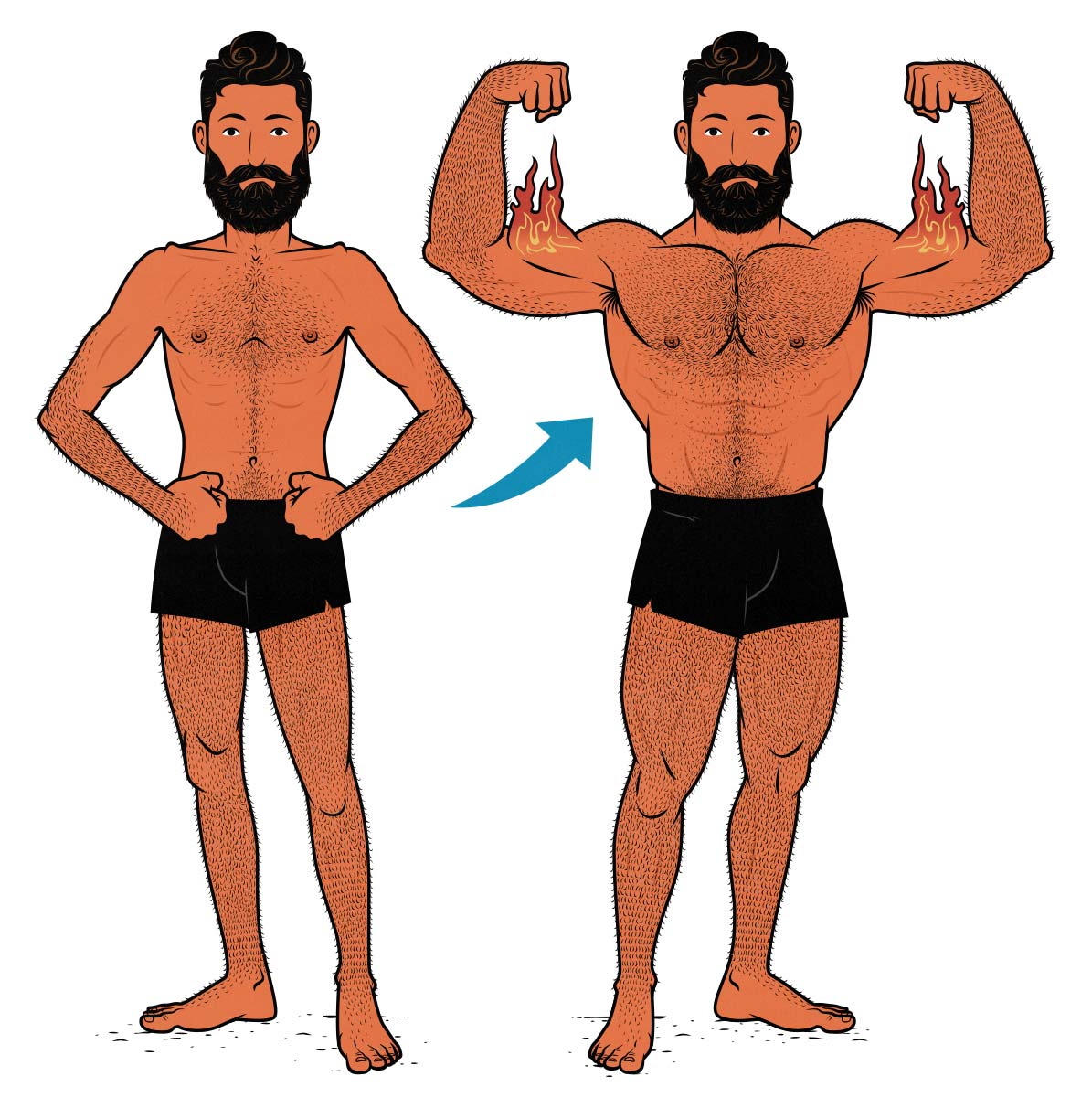
The Story of Milo of Croton
Progressive overload is the foundation of muscle growth. If you can understand it, you’ll understand how to train and eat for muscle growth.
Progressive overload begins with the story of Milo of Croton. Milo was a skinny Greek wrestler who was eager to build muscle. He knew that to stimulate muscle growth, he needed to challenge his strength, so he picked up a calf and carried it up a hill. By the time he got to the top, his muscles were spent. He lay on the ground to catch his breath, then stumbled home, ate a big dinner, and went to bed early.
Two days later, his muscles had not only recovered, but they’d also grown a little bigger and stronger. He was ready to repeat his workout. But the calf had grown a little bit bigger, too, and so by the time he got to the top of the hill, he was just as fatigued as last time. He dragged himself back home, ate an even bigger dinner, and got another good night’s rest.
Two days later, his muscles were feeling ready again, so he carried the calf up the hill a third time. And then a fourth. And then a fifth. He continued this workout routine for two years, by which point the calf had become a bull, and Milo had become the strongest man in all of Greece. That’s not the end of the story. It takes a dark turn. But that’s a story for another article.
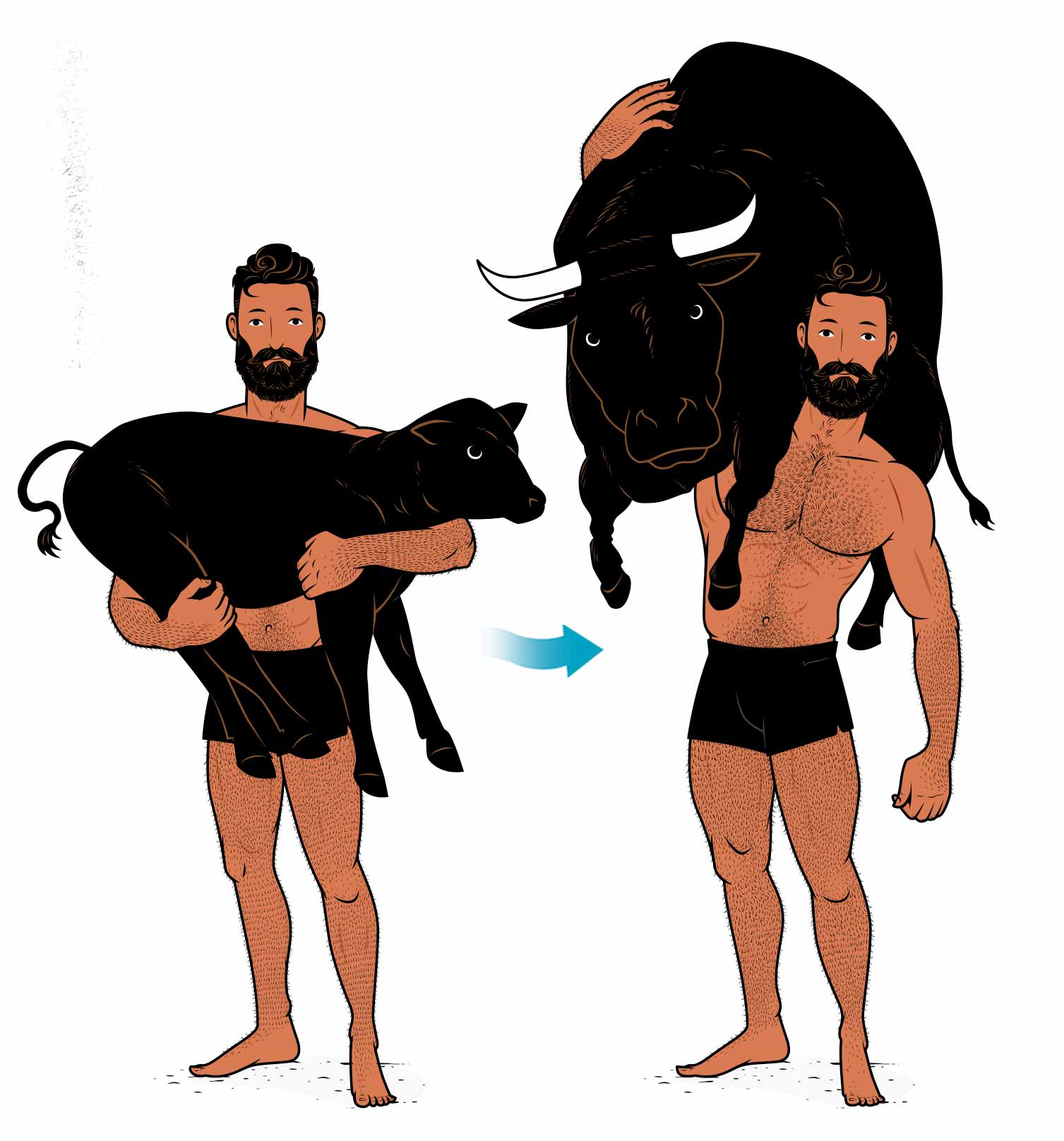
The Principles of Progressive Overload
The idea of progressive overload is to incrementally increase the load as you grow gradually bigger. If you don’t want to increase the load, you could try to squeeze out more reps than last time, lift through a deeper range of motion, or use more difficult exercise variations. The key is to keep challenging your growing muscles. That way, you’re always lifting hard enough to stimulate growth.
Here’s what most people forget: you also need to apply progressive overload to your diet. Every pound of muscle you gain will burn another 10–12 calories per day. As you grow bigger and stronger, you’ll need to eat more food to continue growing.
Progressive overload is a simple framework to understand. Start by doing enough, then do a little more. Simple enough in theory, but not quite so simple in practice. Let’s delve into the details.
The Basics of Building Muscle
To build muscle, you need to challenge your muscles (lift enough), eat enough food to fuel muscle growth (eat enough), and give your muscles time to repair and grow (rest enough). That gives you a clear sequence to follow:
- Lift enough: if you start eating and resting more before you stimulate muscle growth, around 2/3 of the weight you gain will be fat. To stimulate muscle growth, you need to challenge the strength and work capacity of your muscles. The best way to challenge your muscles is with resistance training. There are a few different types of resistance training. You can lift weights, use exercise machines, or do bodyweight workouts. In a pinch, you could even use resistance bands.
- Eat enough: once you’ve started working out, you can start thinking about your diet. Muscle is made out of protein, and most people don’t eat nearly enough protein to maximize their rate of muscle growth. You probably need more. And if you’re skinny or lean, the extra muscle mass will need to come from the food you’re eating, so you’ll also need to be gaining weight.
- Rest enough: once you’ve started working out and eating enough good food, the next thing to consider is recovery. It can be tempting to train every day, to blast your muscles as hard as you can, and to spend all of your motivation on doing more. But it’s when you’re resting that your muscles will grow. You need to wait. And while you wait, the best thing you can do is get enough sleep. If you get enough good sleep each night, you’ll gain way less fat and much more muscle. It’s one of the most powerful things you can do. And it’s incredibly healthy, too.
Building muscle comes down to these three “pillars.” We call them pillars because you need all three of them to support muscle growth. The best workout program won’t help if you aren’t eating enough food. Eating a big bulking diet won’t help you build muscle unless you’ve already stimulated muscle growth. And if you aren’t eating and training for muscle growth, no amount of sleep will help you build muscle. Knock out a pillar, and your castle will crumble.
There are still plenty of details to consider—which exercises to do, how hard to train, what foods to eat, how often to eat, and so on—but they all fit neatly into these three pillars. So let’s go through them one by one, starting at the beginning.
Lifting Enough to Build Muscle
The Different Types of Resistance Training
Different types of resistance training are designed with different goals in mind. Strength training is designed to make you stronger for your size, Olympic weightlifting is designed to increase your explosive power, and hypertrophy training is designed to stimulate muscle growth.
These styles of training are more similar than they are different. All of them can make you bigger, stronger, and more powerful. But if you want bigger muscles, hypertrophy training is much more effective. You’ll build muscle much faster.
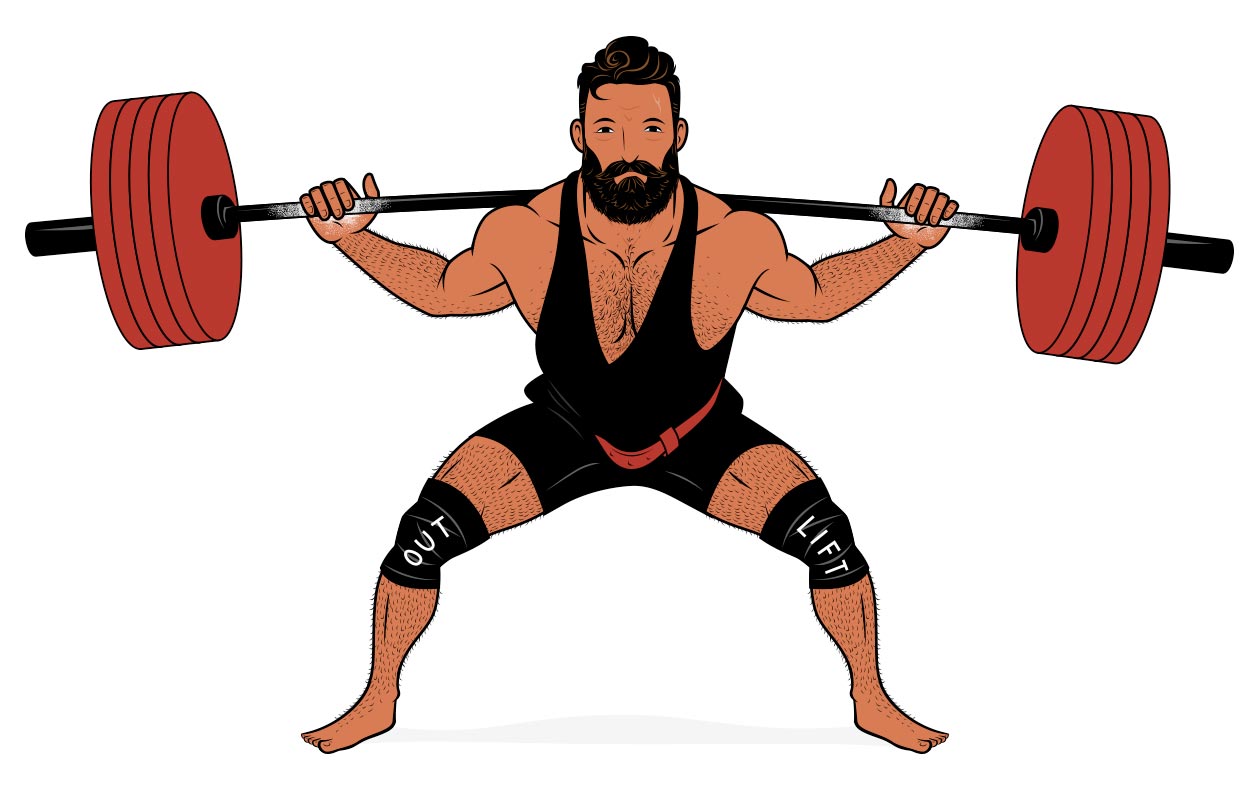
But before we delve deeper, there’s a miscommunication to be wary of. When most people say “strength training,” they’re using the wrong term. They’re talking about resistance training, which includes strength training, calisthenics, and hypertrophy training. In the lifting subculture, “strength training” is more specific. It’s when you train to improve your 1-rep max on the squat, bench press, and deadlift. Think of programs like Starting Strength and StrongLifts 5×5, both of which are rooted in powerlifting.
“Bodybuilding” can be a confusing term, too. When everyday people talk about bodybuilding, they’re thinking of guys who do drugs to look better in speedos. When casual lifters talk about bodybuilding, they’re thinking of training for muscle growth. The technical term for “training for muscle growth” is hypertrophy training, so we’ll use that term instead.
Hypertrophy training isn’t tied to a sport, set of exercises, training method, or posing routine. You can do the exercises that suit you best and emphasize the muscles you most want to grow.
How to Train for Muscle Size
Lifting weights to improve your appearance is often considered vain. It’s more socially acceptable to train for strength, athleticism, or fitness. That’s where hypertrophy training runs into a problem. It’s very good at making people look better.
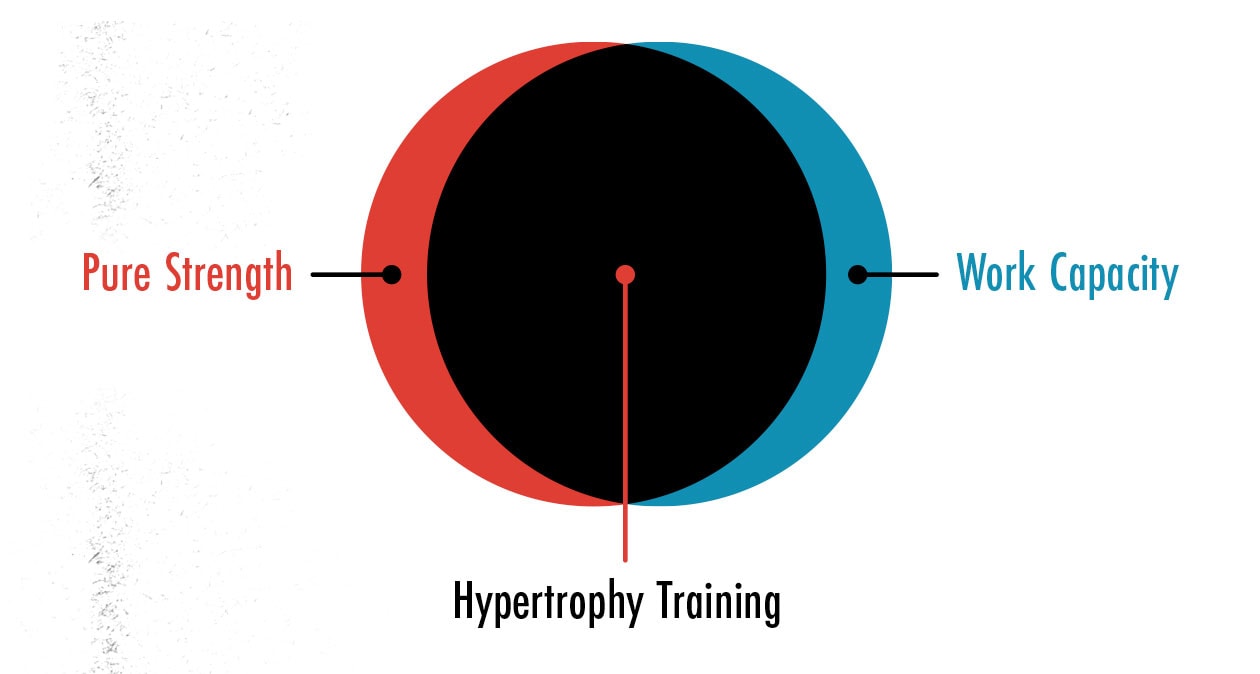
But hypertrophy training isn’t only good for improving your appearance. It’s actually quite similar to strength training, just with more emphasis on improving work capacity than maximal strength. Both styles of training are good for your health, but hypertrophy training has a slight edge. You’ll be doing more work and gaining more muscle, both of which are incredibly good for you.
Hypertrophy training can be used to accomplish a number of different athletic goals, too. Back when Marco was helping college, professional, and Olympic athletes bulk up, he had them doing a mix of hypertrophy training, strength training, and power training.
Bigger muscles are stronger ones. That’s why powerlifters do phases of hypertrophy training in between bouts of strength training. The bigger they can make their muscles, the more weight they’ll be able to lift. You’ll get those same benefits. As long you focus on compound lifts that challenge your stabilizer muscles, hypertrophy training is fantastic for gaining strength.
Hypertrophy training helps us improve our speed and athleticism, too. Bigger, stronger muscles can produce more power. That’s why Olympic weightlifters and sprinters do front squats to bulk up their legs.
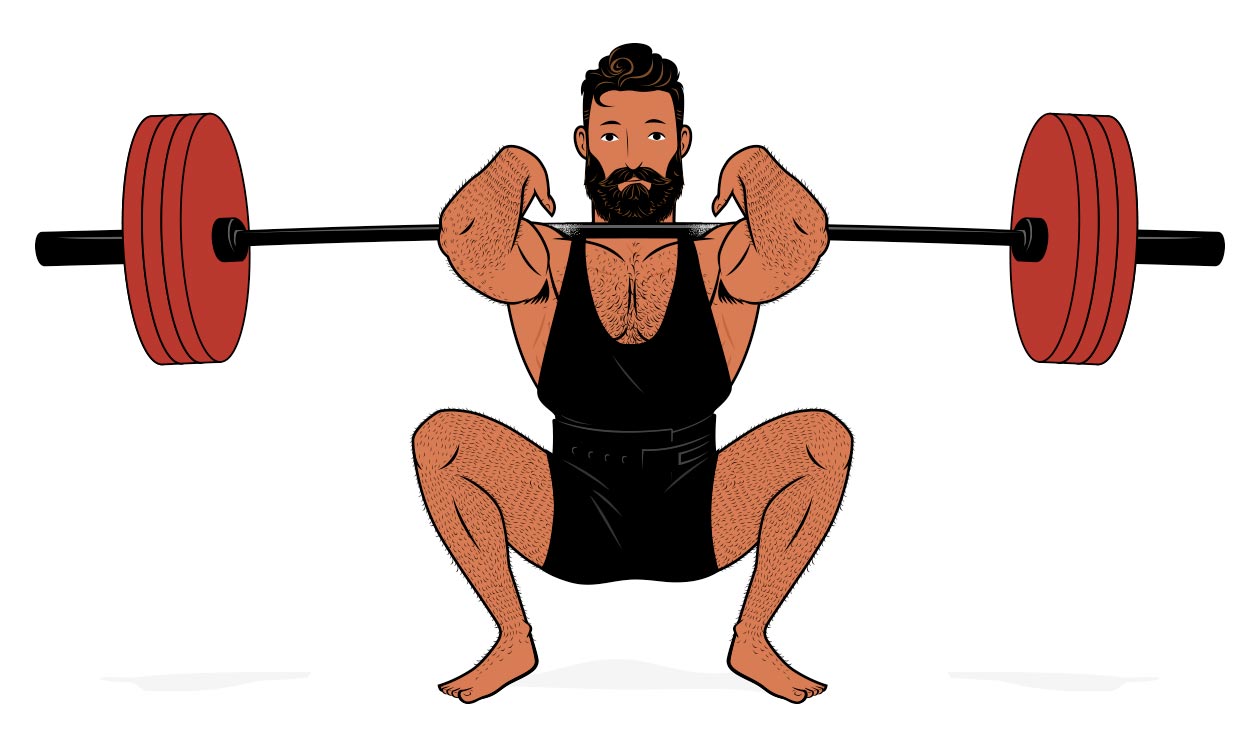
Bodybuilders care about how they look, powerlifters care about their maximal strength, and athletes care about power, but they all use hypertrophy training to build muscle. It builds the foundation of a strong, powerful body.
There are several different tools you can use for hypertrophy training. You can use bodyweight exercises, exercise machines, or free weights (dumbbells and barbells). All of them work, and they work even better when you mix them together.
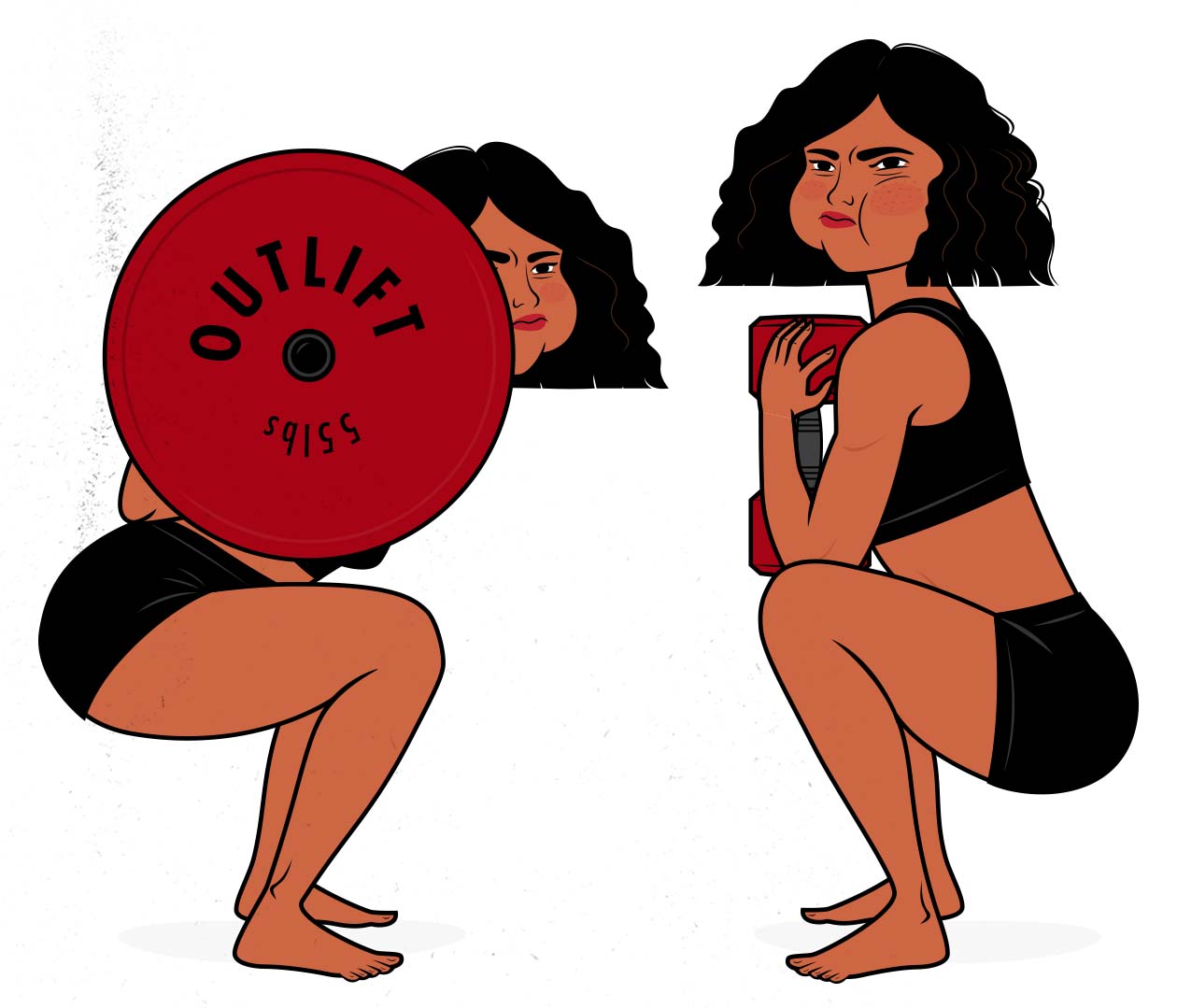
Resistance bands can work. You can build muscle with them. But they’re hardest when your muscles are contracted. It’s better to choose exercises that are harder when your muscles are stretched (like front squats, push-ups, dips, and Romanian deadlifts). Still, if you don’t have access to a commercial gym, a home gym, or your body weight, resistance bands can come in handy.
How to Build Muscle Faster
To stimulate muscle growth, you need to challenge your muscles. As your muscles grow, it will take more to challenge them. So you need to pick exercises that you can load progressively heavier. That’s why barbells, dumbbells, and exercise machines are so valuable. It’s easy to add a little more weight than last time.
If you aren’t adding weight to the lift, you can do more reps instead. If you got 12, 11, and 10 reps last workout, try to get 13, 12, and 11 reps this workout. Every rep you add is progressive overload.
The third way to progress a lift is to go deeper, and this is where the magic happens. When you use a deeper range of motion, the tension from contracting your muscles (active tension) is added to the tension from stretching your muscles (passive tension). When you add these two types of tension together, you can stimulate 2–3x more muscle growth than you would by using a shallower range of motion (meta-analysis, study, study, study).
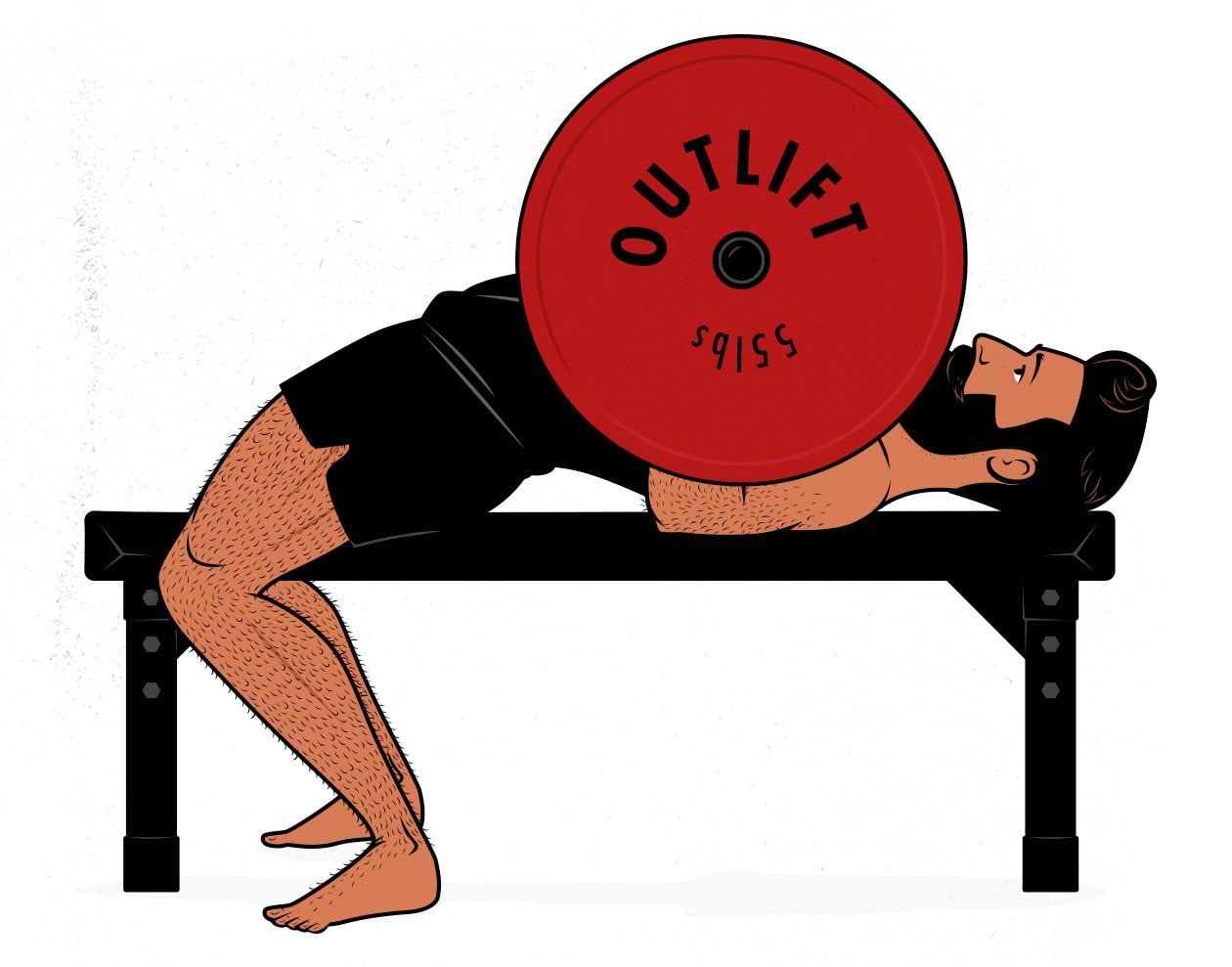
Think of sinking deep into a squat, getting a nice stretch on your quads. Or lowering your chest all the way to the floor when doing push-ups and bench presses, getting a deep stretch on your chest. Or getting a fearsome stretch on your hamstrings at the bottom of a Romanian deadlift.
If you want to build muscle as fast as possible, never compromise depth. Never cut your range of motion short to lift a little more weight or squeeze out an extra rep. Instead, go the other way, lifting as light as you need to go as deep as you can.
The Big Compound Exercises
The best exercises for building muscle are the ones that challenge many different muscle groups at once. Front squats are great for your quads, glutes, and spinal erectors. Push-ups are great for your chest, shoulders, and serratus muscles. Deadlifts are amazing for your hamstrings, hips, and every single muscle in your back. Chin-ups are incredible for your lats, upper back, and abs.
With these four exercises, you can stimulate growth in all the biggest muscles in your body. They make it easy to kill a few birds with one big, heavy stone. If you can get stronger at the big lifts, you’ll grow bigger and stronger overall.
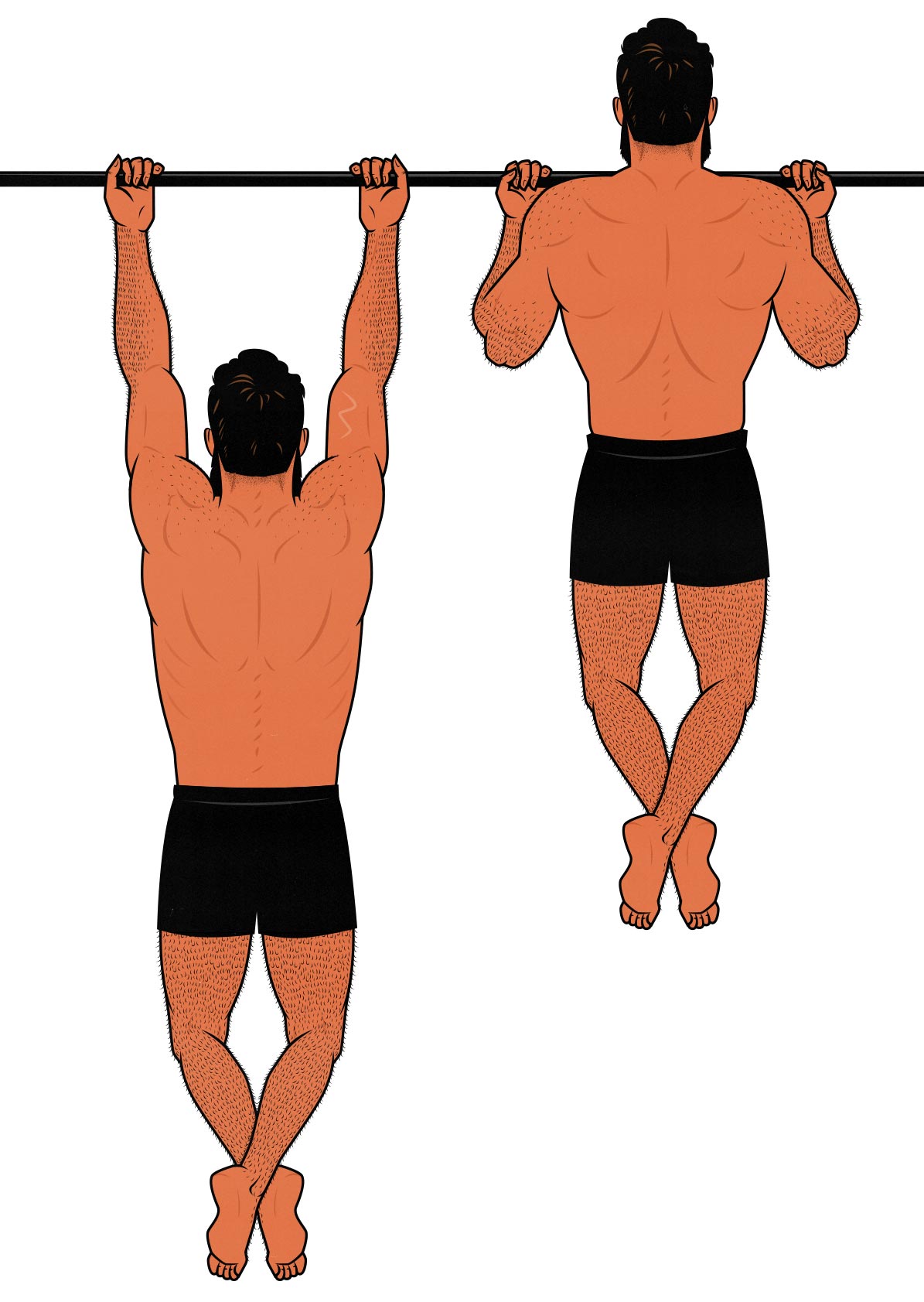
The Power of Small Exercises
Big compound lifts aren’t everything. Many muscles cross more than one joint. Think of your triceps. They open your arms and pull your elbows back. When you’re doing push-ups, presses, and dips, you’re opening your arms but pushing your elbows forward. So what your central nervous system does is turn your triceps halfway off, which is only halfway good for building muscle.
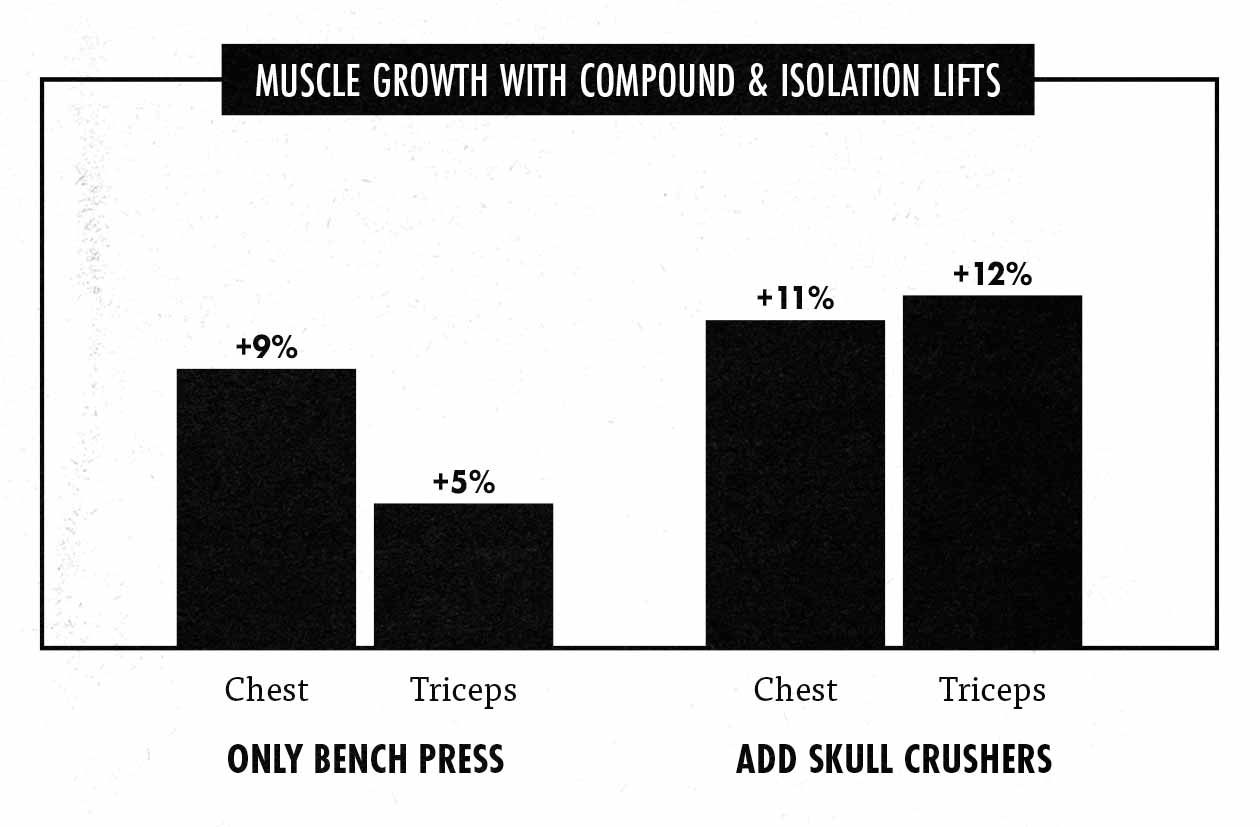
If you want bigger triceps, you need exercises that fully engage them. Think of skull crushers, pushdowns, or overhead extensions. They’ll bulk up your triceps twice as fast.
We see this same effect when comparing rows to biceps curls. Your biceps flex your arms and pull your elbows forward. That doesn’t line up with chin-ups, pull-ups, or rows. Your biceps are built for movements like the biceps curl. That’s why curls are twice as good as rows for building bigger biceps (study).
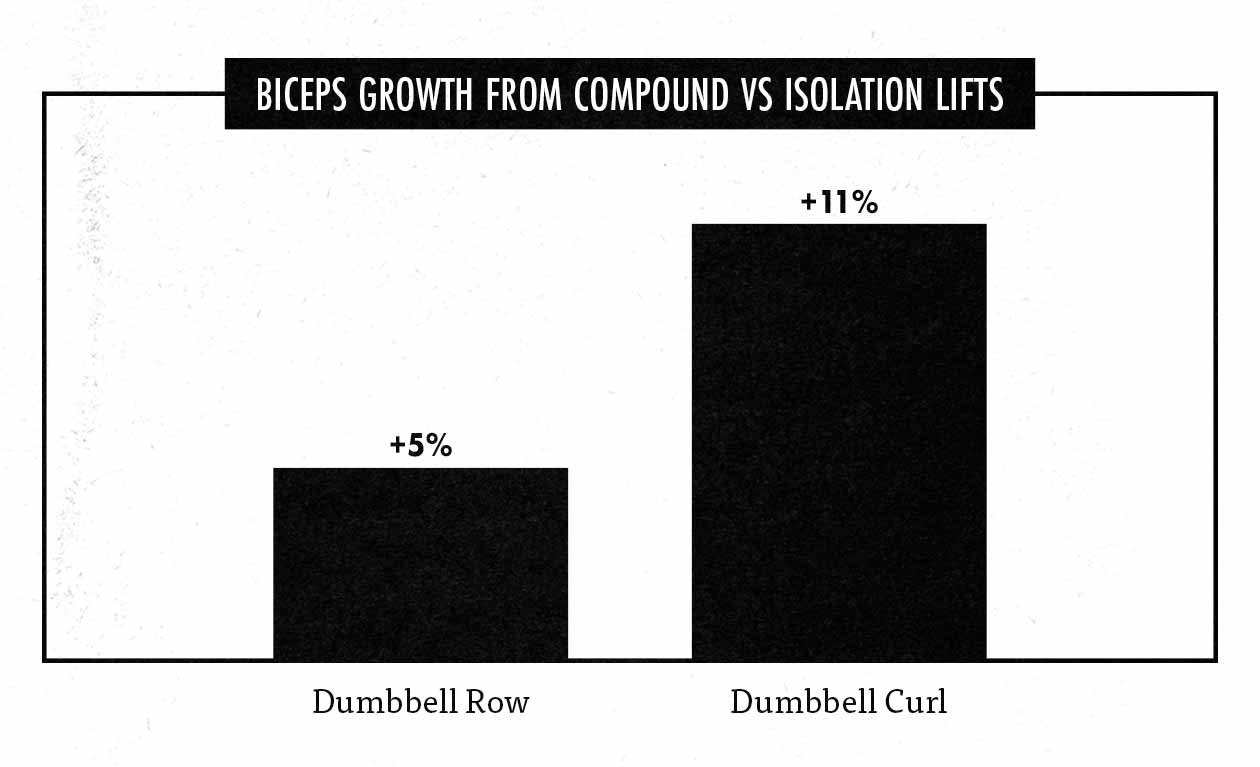
The best way to build muscle, then, is to start with the big compound lifts, then fill in the gaps with smaller isolation lifts. Start with your big pressing exercises (like push-ups), then add in triceps extensions. Start with your big pulling exercises (like chin-ups), then add in biceps curls. Maybe add some lateral raises for your side delts. That’s enough to build a big back, chest, abs, and arms.
Your isolation lifts are up to you. I want bigger arms, so I do triceps extensions and biceps curls. Maybe you want to focus on another muscle group instead. Maybe you want curvier hips, so you add in hip thrusts. Pick the isolation lifts that work the muscles you most want to grow.
The Best Exercises for Beginners
Beginners build muscle faster when they start with brute strength exercises. The big compound exercises are somewhat technical. You need strength and coordination to do them properly. The best beginner exercises are easier to learn and quicker to master, allowing you to push yourself harder sooner.
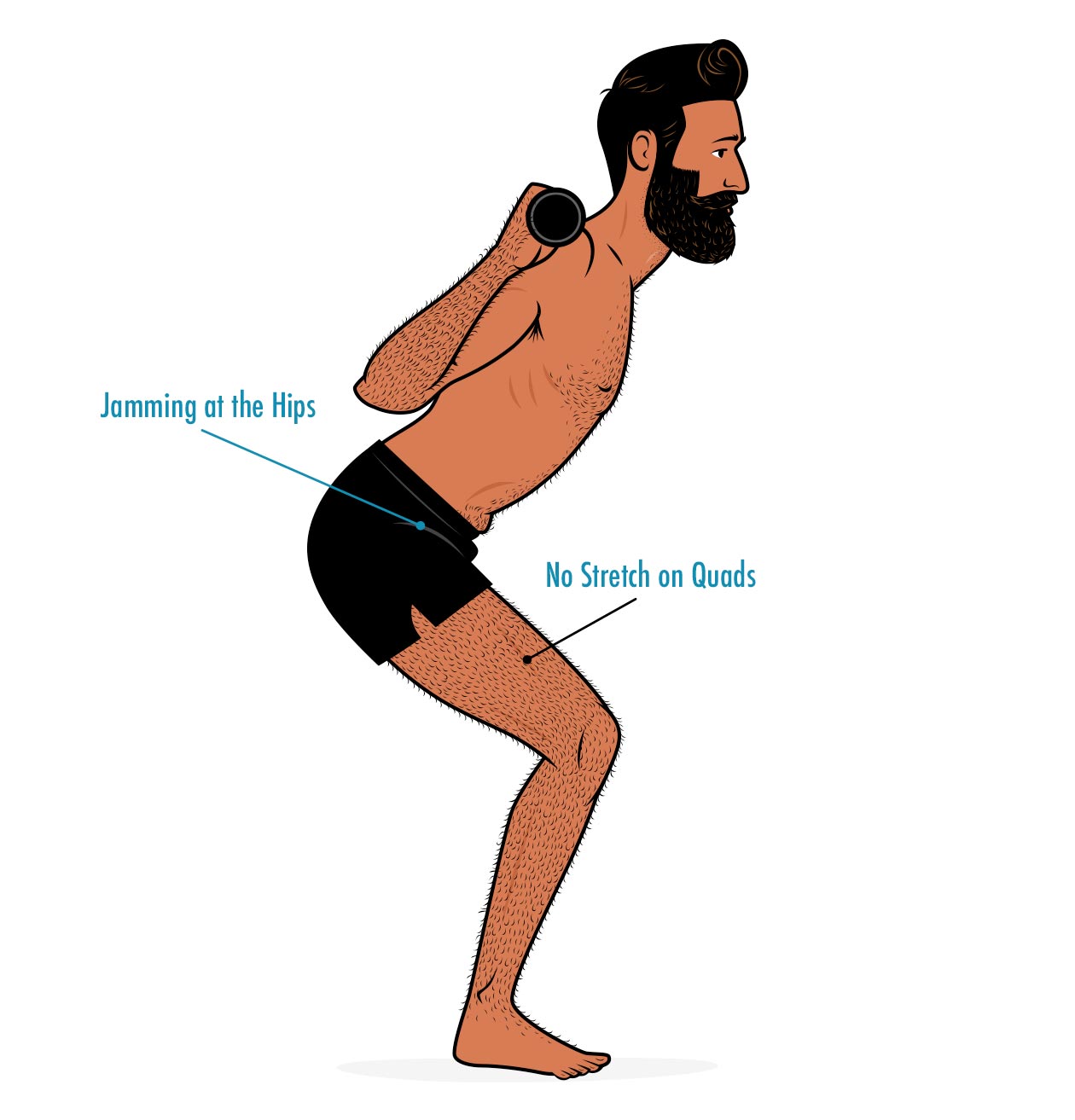
Most beginners find it hard to do deep barbell back squats. Their pelvises tilt forward, their hips jam up, and they get stuck doing “quarter squats”, which aren’t very good for building muscle.
One solution is to hold the barbell in front instead. Front squats make it much easier to squat much deeper. But front squats can be difficult to learn, too. They demand quite a lot of strength and coordination from your core.
That’s where the goblet squat comes in. You hold the weight in front of your body. It’s an intuitive way to hold a weight. It will challenge the strength of your arms and back, yes, but you’ll be able to squat deep without thinking very much about your technique. You’ll be able to train your quads hard under a deep stretch, stimulating a ton of quad growth. And your arms and postural muscles will grow along with them.
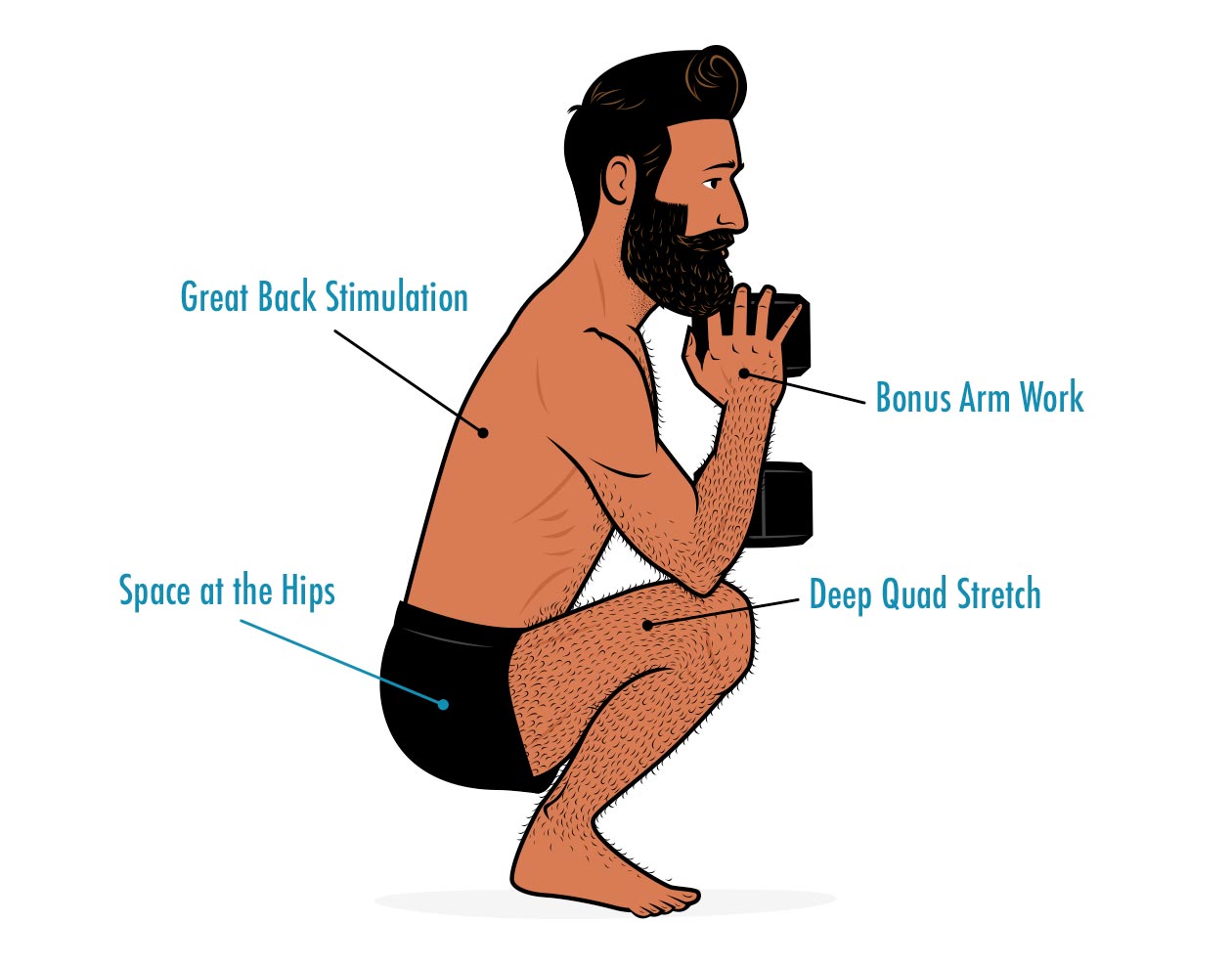
The only problem is that dumbbells only go so heavy. As you grow stronger, you’ll be forced to either grab a second dumbbell or start using a barbell. But if you’re a beginner, that isn’t a problem yet. Take advantage of goblet squats while you still can.
If you’re a beginner, think of exercises like:
- Goblet squats: for your legs, hips, and spinal erectors. They’re also alright for your core, posture, and arms. Leg presses are great, too.
- Push-Ups: for your chest, shoulders, triceps, and abs. Again, they’re also good for your core and posture. Raise your hands up on a bench if you need to.
- Romanian deadlifts: for your hips, hamstrings, traps, and spinal erectors.
- Chin-ups/Pulldowns: for your upper back and biceps. If you can’t do chin-ups yet, start with lowered chin-ups, lat pulldowns, rows, and biceps curls.
- Dumbbell rows: for your upper back, brachialis, and forearms.
After you’ve done your compound lifts, feel free to add some isolation lifts. Not only are they better at stimulating some muscles, but they’re also relatively easy to learn. Plus, they tend to be fairly safe, allowing you to take your sets all the way to failure without fear of injury or embarrassment. Learning to push yourself to the brink of failure is a skill every beginner needs to practice.
Think of isolation exercises like:
- Biceps curls for your biceps.
- Pushdowns or skull crushers for your triceps.
- Lateral raises to build broader shoulders.
- Chest flyes to build a bigger chest
- Planks and side planks for your abs and posture.
- Neck curls/extensions to build a thicker neck.
- Hip thrusts or glute bridges for your hips.
- Leg extensions for your quads.
- Leg curls for your hamstrings.
- Calf raises for your little bulls.
You don’t need to do every isolation lift. You don’t need to include any isolation lifts. But if there’s a muscle you’re particularly eager to grow, it helps to include a dedicated lift for it.
Basic Lifting Terminology
We’re about to dive into the deep end. Before we do, there are a few lifting terms you need to know.
- Repetitions (reps): a repetition is when you do an exercise once. If you squat down and then stand back up, that’s one repetition—one rep.
- Sets: to build muscle, it helps to do 6–20 reps in a row before stopping. Maybe you do ten squats in a row before you rest. We call that a set.
- Volume: you can stimulate more muscle growth by doing more sets. Maybe you do a set of squats, rest for a couple of minutes, and then do another set. That’s two sets. That’s a training volume of two sets.
If you’re doing two sets of squats, and each set has ten repetitions in it, we call that “2 sets of 10 repetitions.” We can shorten than to “2×10.”
If you’re training for muscle growth, you can tally up how many sets you’re doing for each muscle. Two sets of squats are two sets for your quads and glutes. If you do that three times per week, that’s six sets per week. That’s your weekly training volume for those muscles.
How Many Reps Should You Do?
Both heavier and lighter weights stimulate a similar amount of muscle growth. The catch is when you lift heavier weights in lower rep ranges, you’re lifting less weight per set, so you need to do more sets. For instance, someone lifting 100 pounds for 5 reps is lifting 500 pounds per set. That same person could lift 80 pounds for 12 reps, which is 960 pounds. So you might need to do 5 sets of 5 reps to stimulate the same amount of muscle growth as if you did 3 sets of 12 reps.
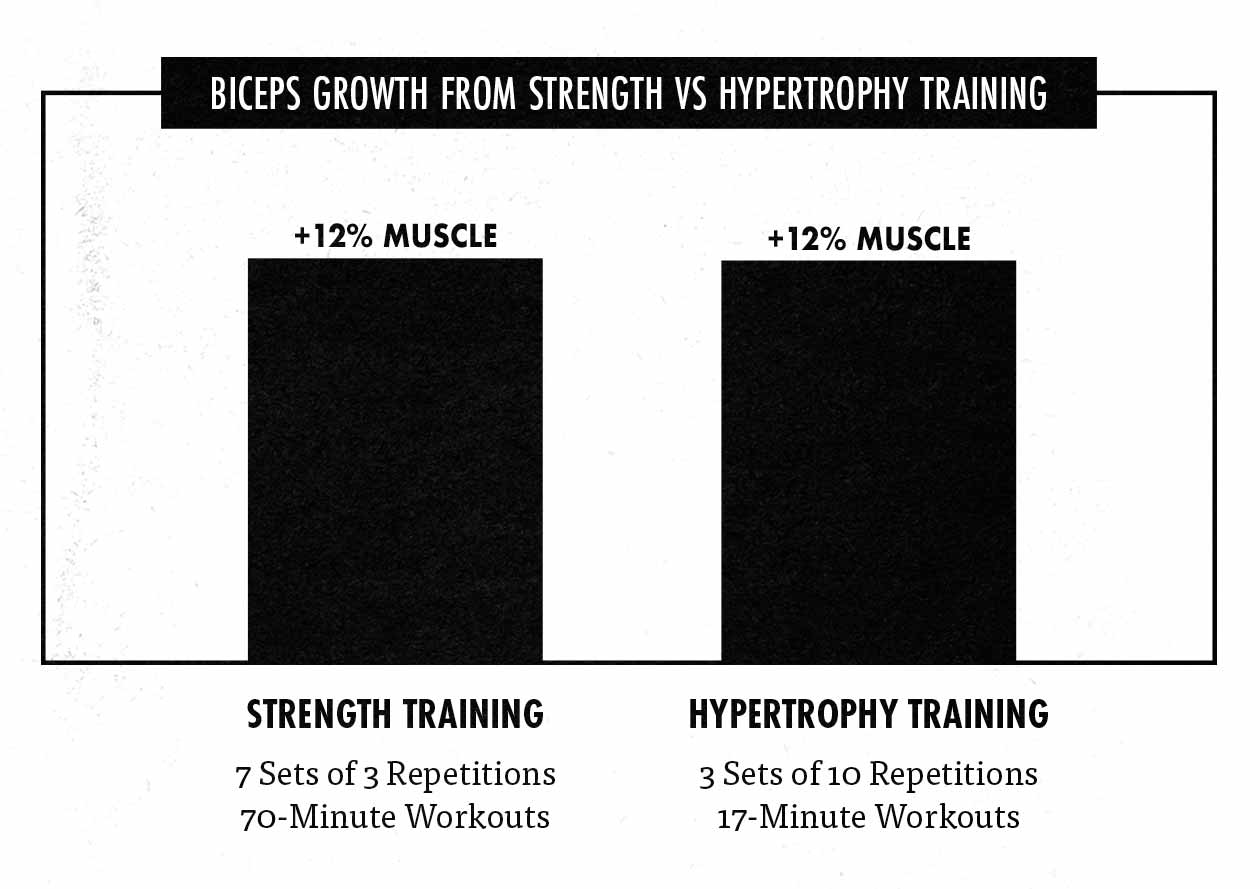
For example, in a study by Schoenfeld and colleagues, they divided the participants into a strength training group and a hypertrophy training group. The strength group trained for 70 minutes, doing 7 sets of 3 reps for each exercise. The hypertrophy group trained for 17 minutes, doing 3 sets of 10 reps for each exercise.
Both groups lifted the same amount of weight overall, and both groups gained the same amount of muscle mass. But the hypertrophy group stimulated more than twice as much growth per set and finished their workouts in a quarter of the time. These results have been replicated by study after study.
Perhaps most importantly, the hypertrophy group could have done more. They felt fresh and eager. They could have trained for a full 70 minutes, doing a variety of other exercises, gaining even more muscle. The strength group, though, was totally spent. They wanted to go home.
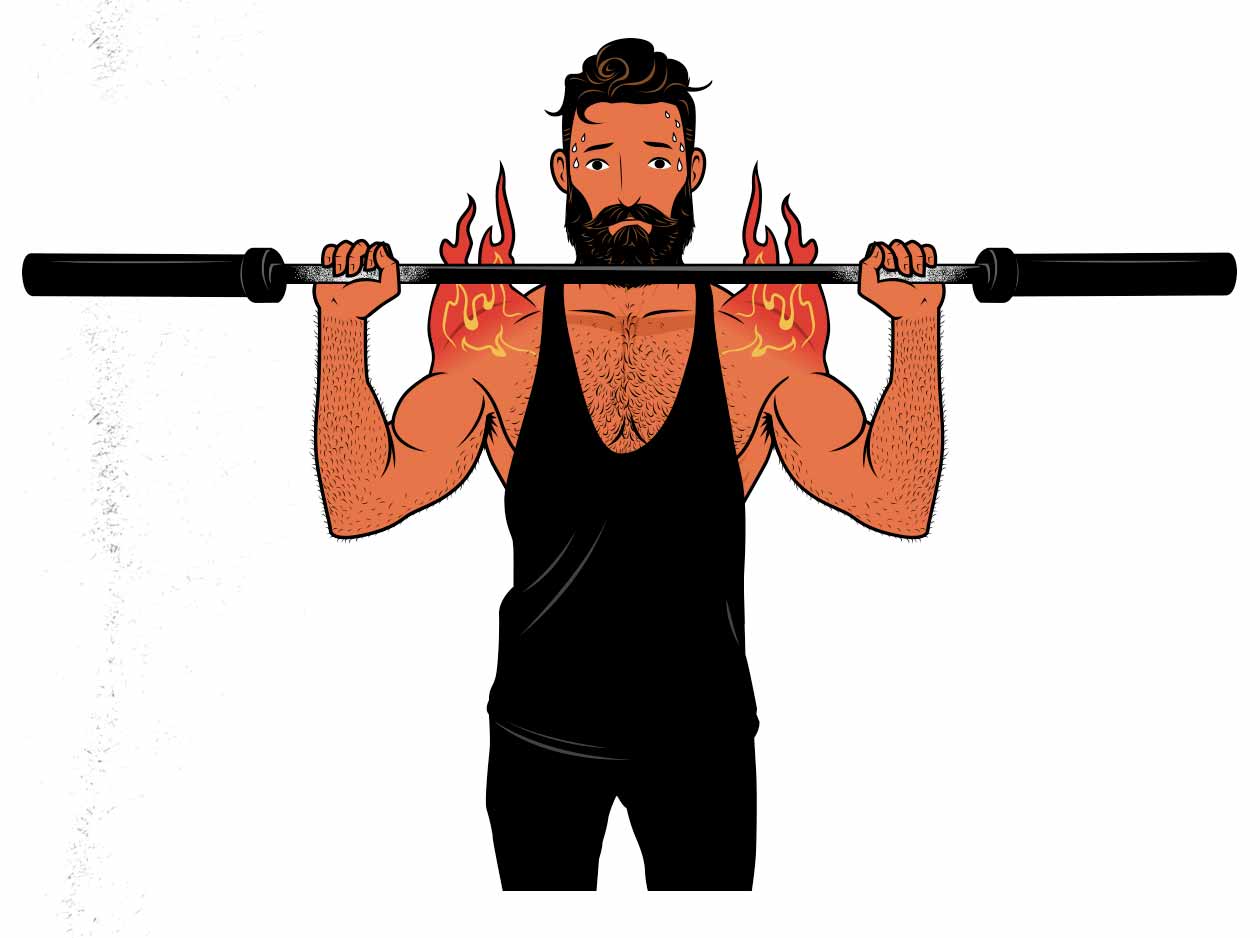
Doing very high reps with very light weights can stimulate muscle growth, too (study, study, study). But again, there’s a catch. You need to bring your sets close to failure, and when you do, the lactic acid build-up is so painful that most people give up or throw up.
Overall, it’s easier and more efficient to build muscle by lifting moderately heavy weights for a moderate number of repetitions. That’s why bodybuilders love the 8–12 rep range. That’s why this idea of the “hypertrophy rep range” has stood the test of time, even though it isn’t quite technically true.
Here’s a good rule of thumb:
- To get stronger for your size: 1–4 reps
- To gain muscle size and strength: 6–20 reps (study)
- To atone for your sins: 40+ reps
We can do a little better than that. Bigger exercises tend to be harder, more tiring, and more painful, so it can help to do fewer reps per set. Smaller exercises tend to be easier, allowing you to handle more reps per set. Here’s a more nuanced approach:
- 5–12 reps for big barbell lifts, such as the squat and deadlift. With big compound lifts, you’re working so much muscle mass that it can hit your cardiovascular system hard. Do too many reps, and you might work your heart harder than your legs.
- 6–20 reps for most other lifts, such as the bench press, overhead press, weighted chin-up, row, hip thrust, biceps curl, and triceps extension. These are moderately heavy lifts, so they suit a moderately heavy rep range.
- 12–30 reps with smaller isolation lifts, such as lateral raises, forearm exercises, and neck exercises. These muscles are small enough that we can do more reps without being limited by our pain tolerance or cardiovascular fitness. High-rep sets of lateral raises burn, but you won’t vomit or want to die.
- Be flexible with bodyweight exercises. Bodyweight exercises are harder to load progressively heavier, so focus on adding reps instead. Maybe when you first start doing chin-ups, you can only do 2–3 of them. Work your way up to 4, then 5, then 6 reps. Maybe you can already do 20 one-legged bodyweight hip thrusts. Work your way up to 21, then 22, then 23 reps.
How Many Sets Should You Do?
Now comes the question of how many sets to do. When you’re lifting in a moderate rep range, you don’t need to do as many sets as if you were strength training. Instead of doing, say, 5 sets of 5 repetitions (5×5) on your compound lifts, you can do 3 sets of 10 repetitions (study). You’ll build just as much muscle, and you’ll save some energy for doing biceps curls later.
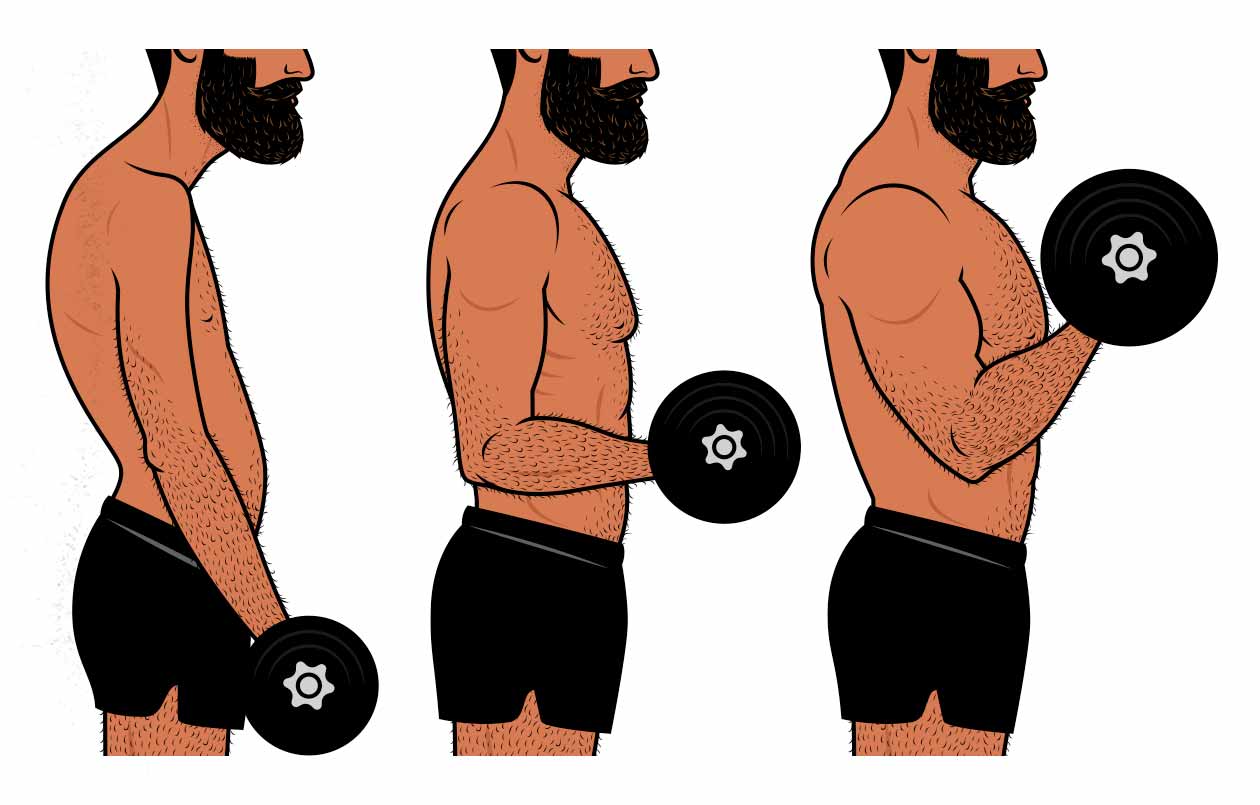
If you’re new to lifting weights, start with fewer sets. Your muscles aren’t tough yet. They’ll get sore very easily. And if you’re too sore for too long, it can interfere with your performance in your next workout, hindering your ability to build muscle.
Start with something like this:
- 2 sets of 8 repetitions for your compound lifts.
- 2 sets of 12 reps for your isolation lifts.
Then add a set each week, working towards something like this:
- 4 sets of 8 reps for your compound lifts.
- 3 sets of 12 reps for your isolation lifts.
If you have trouble adding weight or reps from workout to workout, feel free to add extra sets, especially if the muscles you’re trying to work don’t feel tired, pumped, or sore. This is common for back and shoulder exercises (like rows and lateral raises). Adding extra sets can help.
If you feel beat up and need a break, you can take one. Every 4–8 weeks, it can help to scale your volume back down. Maybe you spend a week doing just 2 sets per exercise, stopping a bit further away from failure. Then build your volume back up.
How Often Should You Work Out?
If you train your muscles vigorously, you can stimulate 2–4 days of muscle growth. If you work out during that recovery period, nothing bad will happen. Your muscles won’t fall off. But you won’t stimulate extra muscle growth, and you’ll have trouble adding more weight or wringing out more reps. It can get in the way of progressive overload.
If you’re a beginner, it’s often best to do a full-body workout every 2–3 days, like so:
- Monday: full-body workout #1
- Tuesday: rest
- Wednesday: full-body workout #2
- Thursday: rest
- Friday: full-body workout #3
- Saturday: rest
- Sunday: more rest
During the week, you get two days of rest, which is almost enough time for your muscles to recover. IYou might still be a little bit sore from your last workout, but you should still be able to outlift yourself. Then, on the weekend, take an extra day of rest to get rid of any lingering muscle damage and soreness.
As you get stronger, you’ll be lifting heavier weights and working bigger muscles. You’ll probably be in better shape, too. You’ll be fitter and tougher. But even so, front squatting 315 pounds is harder than goblet squatting 35 pounds. At a certain point, it’s hard to train every muscle in a single workout. So when full-body workouts become too tiring, you could split your workouts into different muscle groups.
As an intermediate lifter, the world is your oyster mussel. Many different training splits are amazing for building muscle. If you want to emphasize your arms, maybe you try a Bro Split routine, like this:
- Monday: chest day
- Tuesday: back day
- Wednesday: shoulder day
- Thursday: leg day
- Friday: arm day
- Saturday: rest
- Sunday: rest
If you want to improve your athleticism or build a bigger lower body, you could try an Upper/Lower Split:
- Monday: upper body
- Tuesday: lower body
- Wednesday: rest
- Thursday: upper body
- Friday: lower body
- Saturday: rest
- Sunday: rest
How Close to Failure Should You Lift?
People who are good at lifting weights can engage all of their muscle fibres on a whim, grinding through hard reps that would stop a beginner in their tracks. For them, stopping shy of failure is often wise. It causes less muscle damage, generates less fatigue, and stimulates more muscle growth (study, study, study, study, study). On heavy compound lifts, like a 5-rep set of squats, that might mean stopping 2–3 reps short of failure. On a 12-rep set of bench press, that might mean stopping a single rep shy of failure. And with biceps curls and hip thrusts, that might mean lifting until the bar won’t budge.
There’s a bit of an unfortunate truth with beginners, though. They aren’t very good at contracting their muscles yet, making it harder to stimulate muscle growth. Even on the final reps of a hard set, their muscles still aren’t fully firing. And so it turns out that beginners stimulate more muscle growth if they push all the way to muscle failure (study, study, study, study). Now, just to be clear, you can still build muscle without going to failure. But you’ll stimulate even more muscle growth if you do:
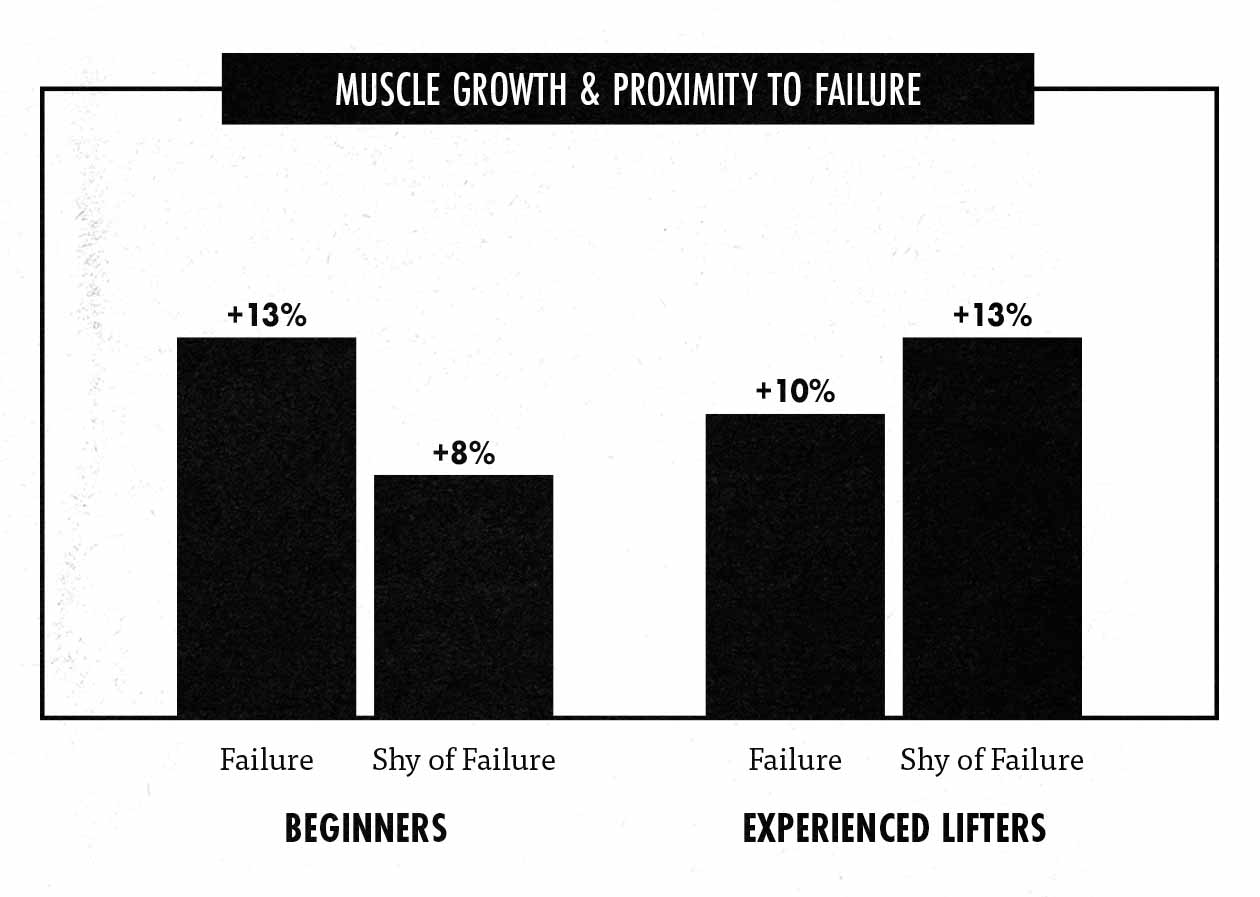
Here’s the other thing. All of these studies were looking at beginners doing simple isolation lifts. Beginners are even worse at challenging their muscles with compound lifts. Beginners would need to pretty much murder themselves with the barbell to stimulate a maximal amount of muscle growth with compound lifts. That isn’t always safe, and it isn’t necessarily ideal for learning good lifting technique.
The good news is that you can combine compound lifts with isolation lifts to get the best of both worlds. Start your workouts with your compound lifts, stopping when your form begins to break down. Maybe that’s a rep or three shy of actual muscle failure. Every workout, try to add a bit of weight or wring out extra reps. Over time, your technique will improve, your stabilizer muscles will grow stronger, and you’ll learn how to engage more muscle mass. As progressive overload catches up with you, you’ll be forced to push your sets closer to failure. That’s how you become an intermediate lifter who’s great at grinding through hard sets.
Then, with your isolation lifts, go all the way to failure, at least sometimes. You don’t need to take every set to failure. But on the final sets of your isolation lifts, lifting to failure is a good way to stimulate some extra muscle growth.
Maybe that means stopping your goblet squats when your back starts to cave in, then doing 2–3 sets of hip thrusts to push your glutes even harder. Then, on the final set of hip thrusts, you go all the way to total muscular failure. That way you’re getting better at goblet squats and maximizing your rate of muscle growth.

The same principle holds true when combining chin-ups with biceps curls or push-ups with dumbbell flyes. You’re engaging more overall muscle mass with your compound lifts, but you’re relying on your isolation lifts to truly challenge your target muscles. That’s how beginners can build muscle at full speed.
How Heavy Should the Weights Be?
When you first start lifting, you won’t know how strong you are. You’ll need to do gradually heavier warm-up sets to find your “working” weight. The bad news is, it’s trial and error. There’s no magic trick or algorithm. The good news is that you need to warm up anyway, and a bit of extra practice never hurt anyone.
To find the right weight, grab a weight that’s much too light. Do 8 reps or so. Then grab a heavier weight and warm up with that, too. Another 8 reps. And then an even heavier weight. 8 more reps.
Keep using heavier weights until those 8 reps start to challenge you. Now you’re getting close. Grab a heavier weight and attempt a working set. Let’s say you’re trying for 10 reps per set. If you get 10 reps, try eking out a few more. If you get a few more, you need an even heavier weight—keep moving up. You’ll know you’ve found the right when you can only do 11–12 reps with it.
On some exercises, you might wind up doing far too many warm-up sets. You might also wind up accidentally hitting failure. That’s okay. The first week of a workout program is usually shorter and easier anyway. You might only have 2 working sets per exercise. Even with the extra warm-up sets, the workout won’t be that long or hard.
How Good Should Your Form Be?
Cautious people tend to focus on lifting with great technique. The problem is, becoming good at something takes practice. Beginners can’t lift with great technique. And so, for fear of getting hurt, careful people tend to lift light weights slowly. But that isn’t enough to challenge their muscles, and so they fail to make progress. They don’t get hurt, but they don’t accomplish very much, either.
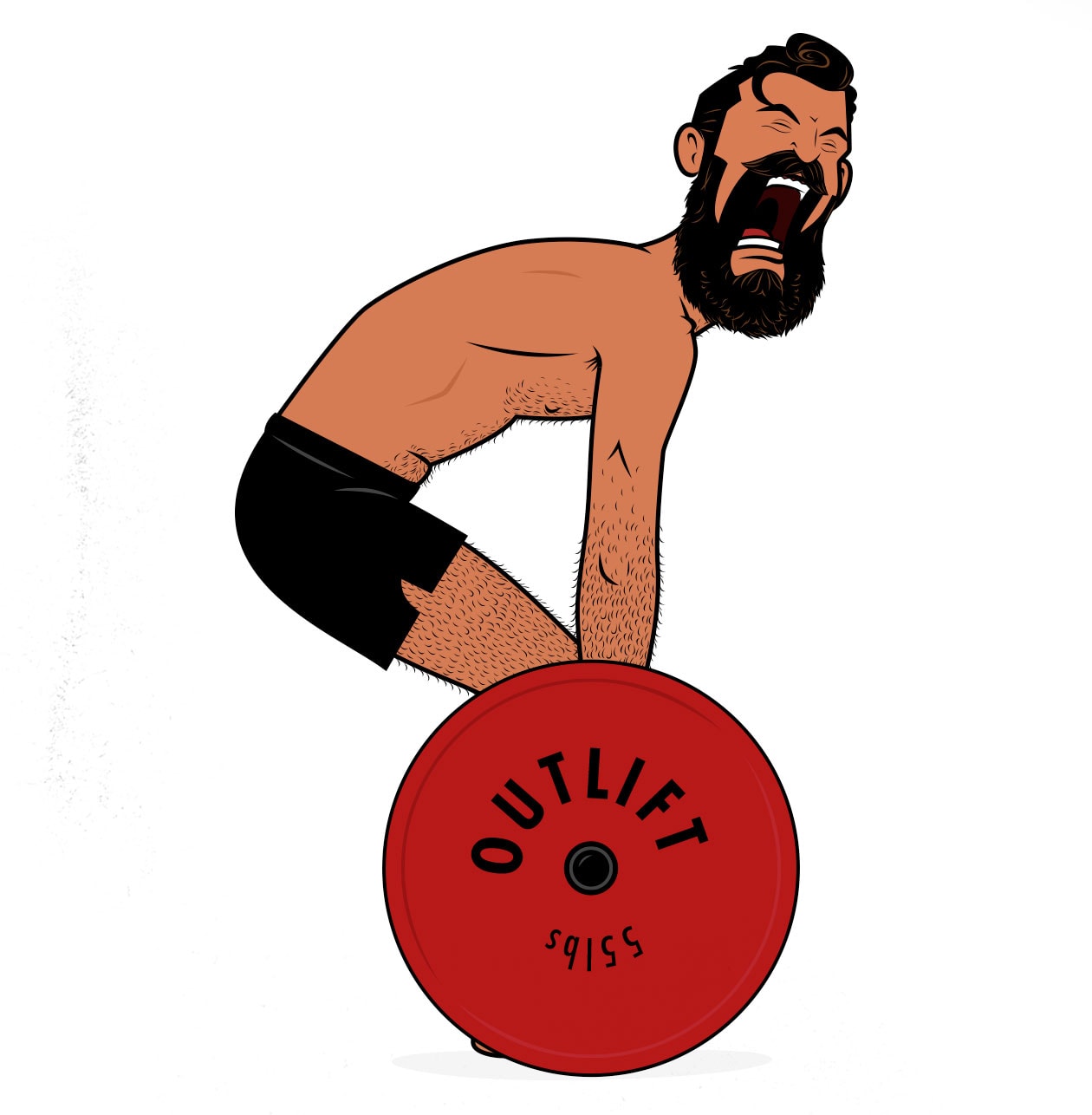
Bold people tend to focus on challenging and pushing themselves. The trouble is, if someone is always focusing on lifting more weight, they’ll be tempted to heave, swing, and cut the range of motion short. They jerk the deadlift bar with a rounded back. They do quarter squats. They swing the barbell up instead of curling it up. This doesn’t always result in injury, but it can. Perhaps a bigger problem is that reckless people never learn to lift properly.
To build muscle, you want the best of both worlds. You want to lift as deep as you can manage, to get gradually better over time, and to push yourself. Think of flooring the gas pedal on a Ferrari. The acceleration is powerful but also smooth. That’s what you should strive for. But it will take practice. It’s okay if your technique is bad at first. We’ve all been there.
The other thing to keep in mind is that flawless, perfect technique is never the goal. Your back will round with the stress of a heavy deadlift. Your stance might not be symmetrical when squatting. Your elbows might flare to different degrees when doing push-ups and bench presses. We aren’t built symmetrically, so if you try to force it, you can get in the way of your natural athleticism. The goal is to lift powerfully and athletically, not to look perfect in the mirror while doing it.
Keep in mind that most beginner lifts are pretty safe. Taking a set of goblet squats all the way to failure just means guiding the dumbbell back down to the floor. No harm done… unless you lose your grip and drop the dumbbell on your toe. So don’t be afraid of taking some of your compound lifts to failure now and then just to see how far away failure really is. Trial and error is the only way to learn how close to failure you’re lifting.
How Long Should You Rest Between Sets?
Rest times don’t matter that much, and beginners don’t need to rest that long between sets anyway. The idea is to rest long enough to get another good set in. If you get 10 reps in your first set and 4 in your second, you know you haven’t rested long enough. You’ve hemorrhaged too many reps. But if you get 10 reps in your first set and 8–9 reps in your second, that’s totally fine.
For beginners, 1–2 minutes is usually enough. If you’re in a hurry, or if you’re keen to improve your fitness, you can time your rest periods. 2 minutes for big compound lifts like squats, push-ups, deadlifts, and chin-ups. 1 minute for smaller lifts like biceps curls, lateral raises, planks, and hip thrusts. If you aren’t in a hurry, you can wait until your heart rate settles down and you’re ready to lift again. Just try not to get too distracted between sets or your workouts might start to drag.
You can also do supersets and giant sets. That way you can cut down on your rest times, keep your heart rate a bit higher, and still give your muscles enough time to recover between sets. To do that, you’d alternate between different exercises. Here’s how that might look:
Circuit 1 (Squat + Chin-Up Superset)
- Goblet squats, rest 1 minute
- Chin-ups, rest 1 minute
- Goblet squats, rest 1 minute
- Chin-ups, rest 1 minute
Circuit 2 (Deadlift + Push-Up Superset)
- Romanian deadlifts, rest 1 minute
- Push-ups, rest 1 minute
- Romanian deadlifts, rest 1 minute
- Push-ups, rest 1 minute
Circuit 3 (Giant Set for Your Arms)
- Biceps curls, rest 30 seconds
- Triceps extensions, rest 30 seconds
- Lateral raises, rest 30 seconds
- Biceps curls, rest 30 seconds
- Triceps extensions, rest 30 seconds
- Lateral raises, rest 30 seconds
This full-body workout will take you about half as long as a regular workout while still stimulating just as much muscle growth. It’s also great for your general fitness.
If you’re doing circuits, the trick is to alternate between exercises that don’t train the same muscle groups. It also helps to choose exercises that can be done without using too much equipment. For instance, to do goblet squats and chin-ups, all you need to do is bring a dumbbell over to the chin-up bar. To do Romanian deadlifts and push-ups, all you need to do is bring your body over to a barbell. And to do biceps curls, triceps extensions, and lateral raises, all you need is a pair of dumbbells or a cable stack.
For more, we have a full article on rest times. There’s some nuance to it. Like how short rest times can be better for bodybuilding “pump” training, whereas longer rest times can be good for strength training and progressive overload. Both have their place in a good muscle-building workout program.
Workout Routines
We’ve outlined a slew of principles. If you’re new to lifting weights, that can be overwhelming. How do you put all of this together into a full workout routine? In this section, we’ll go over some examples. Keep in mind these are just examples. Feel free to modify these workouts however you like. For instance, if an exercise feels bad on your joints, swap it out for a variation that feels better.
You can do these workouts by going from exercise to exercise. But as we explained in the last section, you might prefer to do the exercises as circuits—alternating between 2–3 different exercises. For instance, you could do a set of chin-ups, rest a minute, do a set of goblet squats, rest a minute, and then do your second set of chin-ups. Same with push-ups and Romanian deadlifts. We’ve tried to combine bodyweight movements with weighted movements so that you can do circuits without using more than one piece of equipment. It will make your workouts much shorter and denser without sacrificing any muscle growth.
You can also do these exercises in any order. If someone is using up the equipment you’re waiting for, no problem. Start with another exercise instead. Try to do your compound lifts before your isolation lifts if you can, but the most important thing is to do every set of every exercise, giving each of those sets your best effort.
You’ll notice a lot of repetitions, especially with the compound lifts. This is on purpose. You’ll improve your strength and technique faster if you practice your lifts at least a couple of times per week. We’ve kept the rep ranges fairly constant, too. That way you aren’t spending too much time each workout trying to find the correct weight to use. As you become an intermediate lifter, you can introduce a greater variety of lifts and rep ranges.
If you want to do shorter workouts more often, do the upper-body lifts one day, the lower-body lifts the next day. That will turn this 3-day full-body routine into a 6-day upper/lower split routine. Either way, you’ll be doing the same amount of work and stimulating the same amount of muscle growth. Totally up to you.
Beginner Workout Routine for Men
Here’s a simple beginner workout routine for a skinny guy who’s especially eager to bulk up his upper body and improve his appearance. You can do it at a full gym, or you can use dumbbell or barbell variations at home.
If you want to know how to do the exercises, just click the link. It will take you to a YouTube video of Marco teaching one of the many variations of each movement. The videos are simple because lifting should be simple, especially as a beginner. Think more about moving naturally, less about micromanaging every aspect of the exercise. You’ll improve over time.
Workout 1
- Chin-ups*: 4 sets of as many reps as possible (AMRAP)
- Goblet squats: 3 sets of 10 repetitions (3×10)
- Push-ups: 3×AMRAP
- Romanian deadlifts: 3×10
- Biceps curls: 2×12
- Triceps pushdowns: 2×12
- Lateral raises: 2×15
Workout 2
- Goblet squats: 3×10
- Push-ups: 3×AMRAP
- Romanian deadlifts: 3×10
- Dumbbell rows: 3×10
- Reverse flyes: 2×15
- Front planks**: 2 sets for longer than last time
- Side planks**: 2 sets for longer than last time
Workout 3
- Chin-ups*: 4×AMRAP
- Goblet squats: 3×10
- Push-ups: 3×AMRAP
- Romanian deadlifts: 3×10
- Biceps curls: 2×12
- Triceps pushdowns: 2×12
- Lateral raises: 2×15
*Not everyone can do chin-ups right from their very first workout. One solution is to start with lowered chin-ups. Eventually, you’ll grow strong enough to pull yourself up. Or, if you’re training at a full gym, you can do lat pulldowns for 3 sets of 10 repetitions until you’re strong enough to do 3+ chin-ups. If you’re training at home, you can do rows and biceps curls.
**Planks are great for teaching beginners how to maintain a strong posture while lifting, and they’re a halfway decent way to build bigger abs and obliques. But if your posture is good and you want to skip ahead, you can swap them out with any isolation lift. For example, if you want to build a thicker neck, you could do neck curls and extensions.
Beginner Workout Routine for Women
For example, here’s a simple beginner workout routine for a skinny woman who wants to get stronger overall, build a bigger butt, and improve her appearance.
If you want to know how to do the exercises, clicking the link will take you to a YouTube video of Marco teaching a variation of each exercise. The videos are simple because lifting should be simple, especially as a beginner. Think more about moving naturally, less about micromanaging every aspect of the exercise. You’ll get better over time.
Workout 1
- Goblet squats: 3 sets of 10 repetitions (3×10)
- Dumbbell rows: 3×10
- Raised push-ups: 3 sets of as many reps as possible (AMRAP)
- Romanian deadlifts: 3×10
- Bodyweight hip thrusts: 3×AMRAP
- Lateral raises: 2×20
Workout 2
- Goblet squats: 3×10
- Lat pulldowns*: 3×10
- Raised push-ups: 3 sets of as many reps as possible (AMRAP)
- Romanian deadlifts: 3×10
- Bodyweight hip thrusts: 3×AMRAP
- Front planks**: 2 sets for longer than last time
- Side planks**: 2 sets for longer than last time
Workout 3
- Goblet squats: 3×10
- Dumbbell rows: 3×10
- Raised push-ups: 3×AMRAP
- Romanian deadlifts: 3×10
- Bodyweight hip thrusts: 3×AMRAP
- Lateral raises: 2×20
*If you’re strong enough, you can start with lowered chin-ups or even full chin-ups. Otherwise, spend a few weeks doing rows and pulldowns first. That will develop the strength you need to do chin-ups later.
**Planks are great for teaching beginners how to maintain a strong posture while lifting, and they’re a good way to build bigger abs and obliques. But you can swap them out with any isolation lift. For example, if you want to build thicker legs, you could do leg curls and extensions.
For more, we have a full article teaching all of these lifts and going into more specifics.
Eating Enough to Build Muscle
Eating Enough Calories
If you eat more calories than you burn, you’ll gain weight. If you’re following a good workout program, your body will be eager to invest those calories into muscle mass. When the floodgates open and the food floods in, your body will build as much muscle as it can. Any calories that can’t be invested into muscle growth will be burned off or stored as body fat.
If you were overweight, you could skip this part. Overweight people already have surplus calories stored as body fat. They can build muscle without gaining weight. The problem is, if you’re skinny or lean, your body doesn’t have any fat stores to dip into. You need the little fat you have. Having that small baseline level of body fat is important for your health, energy levels, and hormones. It can come in handy in an emergency, too.
So, if you’re thin and you want to build muscle, the extra energy needs to come from the food you’re eating. This is why bodybuilders and powerlifters say you have to “eat big to get big.” There’s truth in that. That’s where bulking comes in.
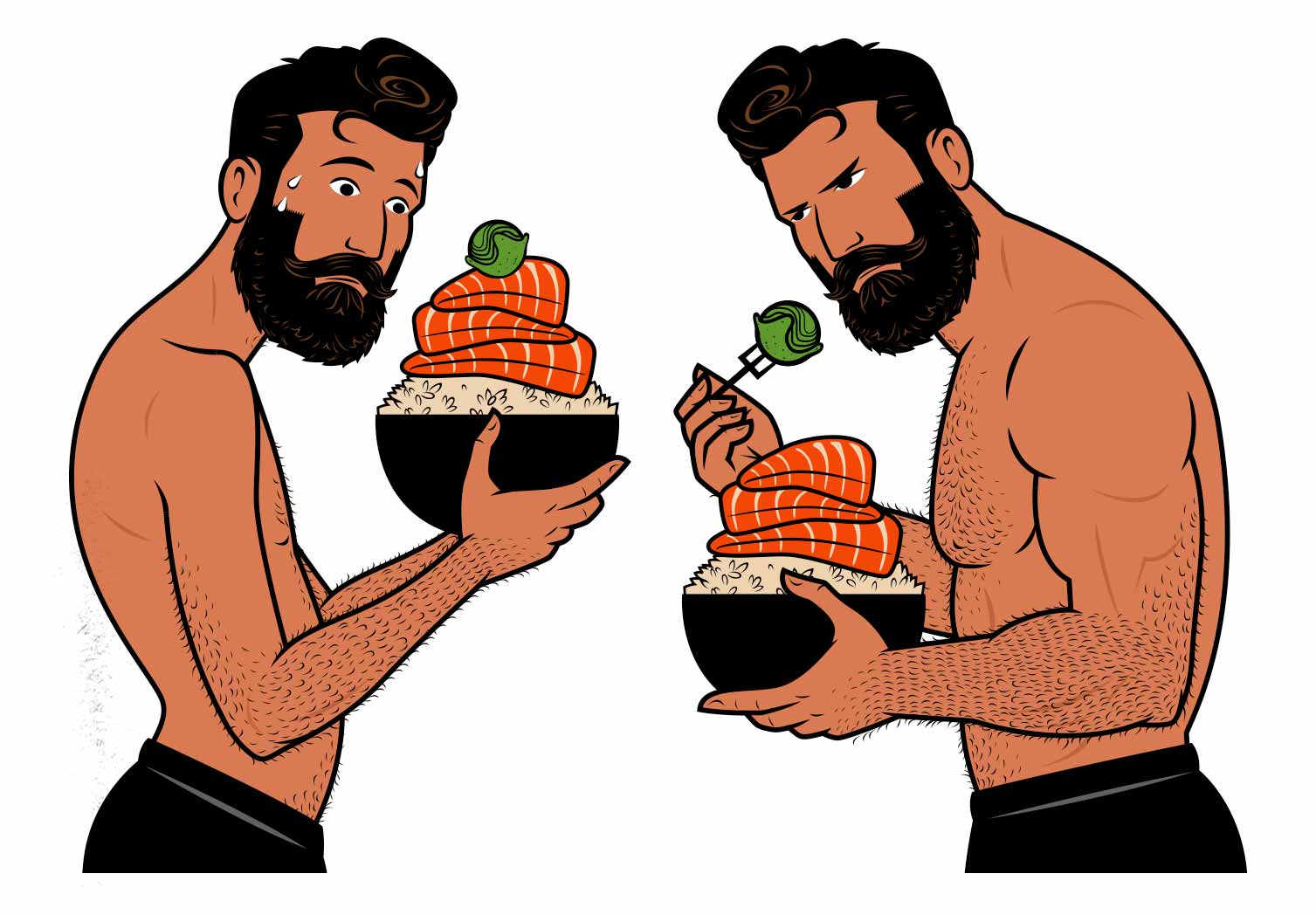
What is Bulking?
“Bulking” is when you gain weight to facilitate muscle growth. And if you’re following a good workout routine, your weight gain is slow, and your diet is good, bulking can work wonders. You can gain a tremendous amount of muscle and strength. Slowly and steadily, yes. But even slow gains add up fast.
Bulking is how I went from 130 pounds up to 200 pounds at 11% body fat. It’s how Marco went from 150 pounds up to 220 pounds at 10% body fat. It’s how my wife went from 97 to 119 pounds at 20% body fat. It’s what we’ve spent the past 10 years helping over 10,000 clients do. If you do it right, you can build a ton of muscle.
The catch is, the calories that aren’t used to build muscle will be burned off or stored as body fat. And the more calories you eat, the more calories will be left to spill over into fat storage. That’s why larger calorie surpluses tend to cause more muscle growth but also more fat gain.
That’s why if you bulk too aggressively, you may need to spend a few weeks burning off the extra fat you gain. No big deal. Most strong people have been there. I sure have. But even better if you can learn from our mistakes.
How Fast to Gain Weight
In a study by Ribeiro and colleagues, the first group of participants ate an aggressive bulking diet, gaining around a pound per week. They gained 4 pounds of muscle for every pound of fat they gained. Their body fat percentage barely changed at all. In fact, for people starting at over 20% body fat, their ratio of muscle-to-fat gain was good enough ratio to reduce their body fat percentage.
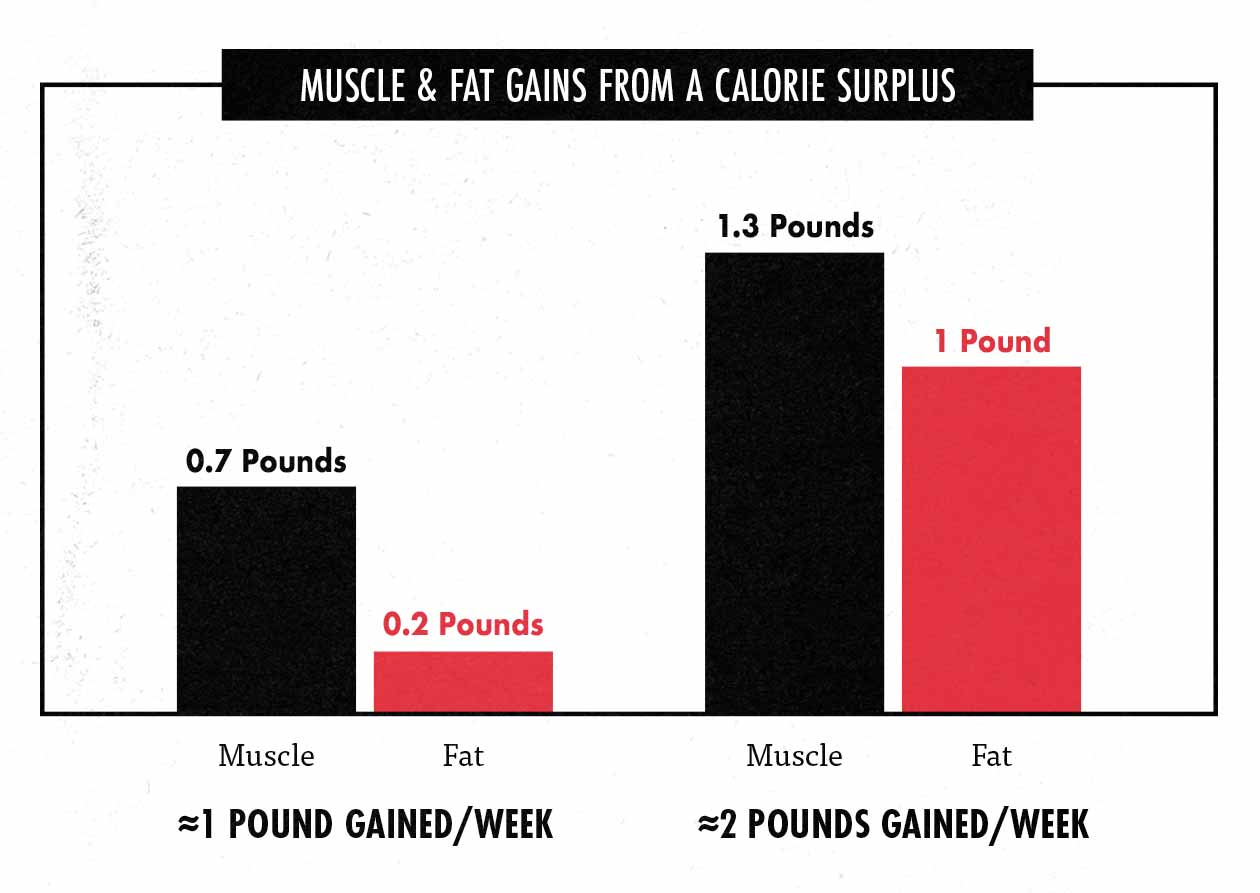
The second group was told to eat even more calories, gaining a whopping 2 pounds per week. This a bulking diet more aggressive than I’ve ever seen recommended by anyone. But, uh, I’ve done it. Back when I was 6’2 and 130 pounds, I gained 2+ pounds per week until I got up to a healthy weight. I was too desperate to build muscle. I couldn’t muster up any patience. And to be honest, it paid off. I was starting off so underweight that I still finished looking better than when I started.
Anyway, this second group of participants gained twice as much muscle as the first group, but they also gained five times more fat. It wasn’t a terrible ratio—they gained a pound of muscle for every pound of fat. Still, it’s enough fat that you might need to spend a few weeks “cutting” it off.
A traditional bulk has people gaining around 0.25–1 pound per week (study). The above study shows that gaining weight at the upper end of that range results in fairly lean gains, at least at first. But everyone is different. People who are smaller, fatter, or more muscular than average might benefit from a slower pace. The slower you bulk, the less fat you’ll gain.
Can You Build Muscle Without Gaining Weight?
As we mentioned above, some people can build muscle without gaining weight. That’s called body recomposition (or recomping). If you’re skinny, muscular, or lean, though, then you’ll probably need to gain weight to build a noticeable amount of muscle.
If you’re an overweight beginner, you don’t necessarily need to focus on calories yet. You could start by making sure you’re eating enough protein. After that, just try to make good food choices. More whole foods, fewer processed foods. More meat, dairy, poultry, eggs, fish, legumes, fruits, veggies, Greek yogurt, kefir, seeds, and nuts. Less oil, butter, sugar, soda, juice, and junk food.
That isn’t to say that foods like butter are “bad” or that you should be trying to totally eliminate them. Just that if you’re trying to lose weight, it will be easier if you get more of your calories from filling whole foods—more fibre, more water, more chewing, and more protein. If you want a specific goal, aim to get 80% of your calories from whole foods. That’s usually enough to get all the vitamins, minerals, fibre, and phytonutrients you need to build and maintain a strong and robust body.
If you’re skinny, muscular, or lean, you’ll need to gain weight to build a noticeable amount of muscle size and strength. If you aren’t carrying lots of extra fat, your body won’t burn your body fat to build muscle. It wants that fat. It’s usually better to be at around 10–15% body fat than to be at 7–12% body fat. Your body won’t want to drop below a certain threshold. You’ll need to gain weight to gain muscle.
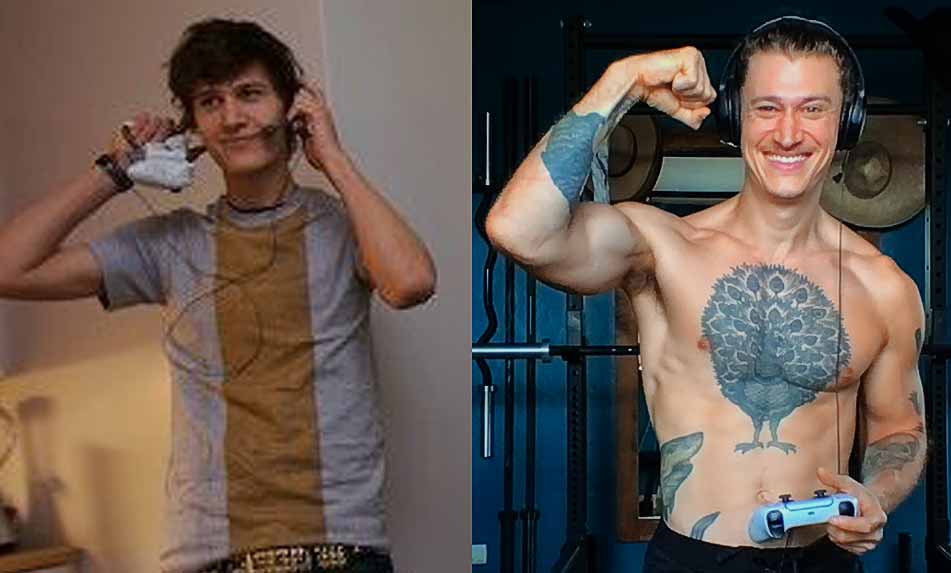
Plus, if your goal weight is heavier than you are now, you obviously need to gain weight to get there. When I was a skinny 130 pounds, the only way to get up to 190 pounds was to gain weight. Until I learned how to eat more food, I wasn’t able to make any progress at all. To get bigger, I had to eat bigger. Just don’t rush it. Gaining 0.25–1 pound per week is plenty.
Do Calories Really Matter?
You’ll hear some people argue that calories aren’t a useful measurement tool. They’ll argue that food labels aren’t accurate enough, that people don’t track their calories well enough, and that different people burn different amounts of calories based on their activity levels, genetics, and even hormones.
Plus, different foods have different effects on body composition. For instance, protein can help with muscle growth, carbs can be stored in our muscles as glycogen, fat is readily stored as body fat, and insoluble fibre passes right through. Different macronutrients also affect our body temperature differently. For example, when you digest protein and carbs, some of the energy is burned up as body heat.
Because of how complicated calories can get, people often get confused. You might hear someone argue that they were in a calorie deficit but didn’t lose weight. Or that they were in a calorie surplus but didn’t gain weight. That’s not true. They just weren’t accurate enough when tracking how many calories they ate or burned. And I don’t blame them. It’s virtually impossible to track exactly how many calories you’re eating and burning.
Calories still matter, though. If you’re in a calorie surplus, you’ll gain weight. If you’re in a calorie deficit, you’ll lose weight. Yes, it’s hard to precisely track how many calories you’re eating and burning, but the only way to gain or lose weight is to adjust your calorie intake.
That’s where the principle of progressive overload comes into play. Whether or not you count calories, the trick is to adjust how much you’re eating based on how much weight you’re gaining or losing. If you aren’t gaining weight, eat more food. If you keep this principle in mind, your calorie intake will be self-correcting, even if you totally suck at estimating how many calories you eat and burn.
How to Gain Weight Without Counting Calories
You can gain weight without counting calories. You still need to be in a calorie surplus, it’s just that you don’t have to count the calories you’re eating. Just add food into your diet. More precisely, add around 250–500 extra calories. That’s a tall glass of milk, a serving of trail mix, or a Quest bar with a piece of fruit.
The thing is, your appetite will guide you towards maintaining your weight. If you add 250 calories at breakfast, you might skimp on 250 calories at dinner. Or skip a snack. Or have 3 desserts that week instead of your usual 5. So this idea of adding extra calories works better for people who eat very steady diets. If you always eat the same oatmeal for breakfast, the same sandwich at lunch, and a similarly-sized family dinner, this can work great. This can be simple.
The most important thing is to weigh yourself every week and adjust accordingly. If you aren’t gaining weight, you need to add in a little bit more food. So keep weighing yourself and adjusting. If a couple of weeks go by where you haven’t gained weight, it’s time to up the calories.
How Many Calories Do You Need to Build Muscle?
Women need fewer calories and should gain weight more slowly. For a very rough idea of how many calories you need per day, multiply your weight in pounds by 14–15. If you weigh 110 pounds, that’s 1600 calories per day. From there, weigh yourself every week, aiming to gain around 0.25–0.5 pounds. If you gain less than 0.25 pounds per week for two weeks in a row, eat 200 more calories. If you gain more than 0.5 pounds for two weeks in a row, eat 100 fewer calories. Keep adjusting how much you eat so that you’re always gaining around 0.25–0.5 pounds per week. (For more, we have a full diet article for women.)
Men need more calories and can gain weight faster. For a super rough idea of how many calories you need per day, multiply your weight in pounds by 18–20. If you weigh 120 pounds, that’s 2500 calories per day. From there, weigh yourself every week, aiming to gain around 0.5–1 pound. If you gain less than 0.5 pounds per week for two weeks in a row, eat 200 more calories. If you gain more than 1 pound for two weeks in a row, eat 100 fewer calories. Keep adjusting how much you eat so that you’re always gaining around 0.5–1 pound per week. (For more, we have a full bulking diet article for men.)
If you want to minimize fat gain, stick to the bottom of the weight-gain range. The less weight you gain, the less likely you are to gain fat and the more likely you are to lose it. The downside is that you won’t gain muscle as quickly. And for now, that’s okay.
If you’re skinny and lean, you can gain weight more aggressively. Calorie estimates change a little bit for people who are naturally thinner and leaner. So-called “ectomorphs” and “hardgainers.” Ectomorph is a slang term, so don’t read too much into it. “Hardgainer” is a real scientific term, though. In either case, these words exist because naturally thinner people often struggle to gain weight. I’m one of those people. I always had a really hard time eating enough calories to gain weight. Point is, you might need to eat even more calories than most algorithms estimate.
If you’re underweight, you can probably get away with gaining weight more quickly. We usually recommend that skinny women gain around 0.5 pounds per week and that skinny men gain around 1 pound per week. You may also want to start your diet off with an extra 200–300 calories in it.
How to Adjust Your Diet Based on Your Results
Whether you count calories or not, keep in mind that these are just starting points. The important thing is to weigh yourself every week, see how much weight you gain, and then adjust how much you’re eating. If you’re not gaining weight fast enough, eat another 200 calories every day. If you’re gaining weight too fast (or gaining fat), eat 100 fewer calories.
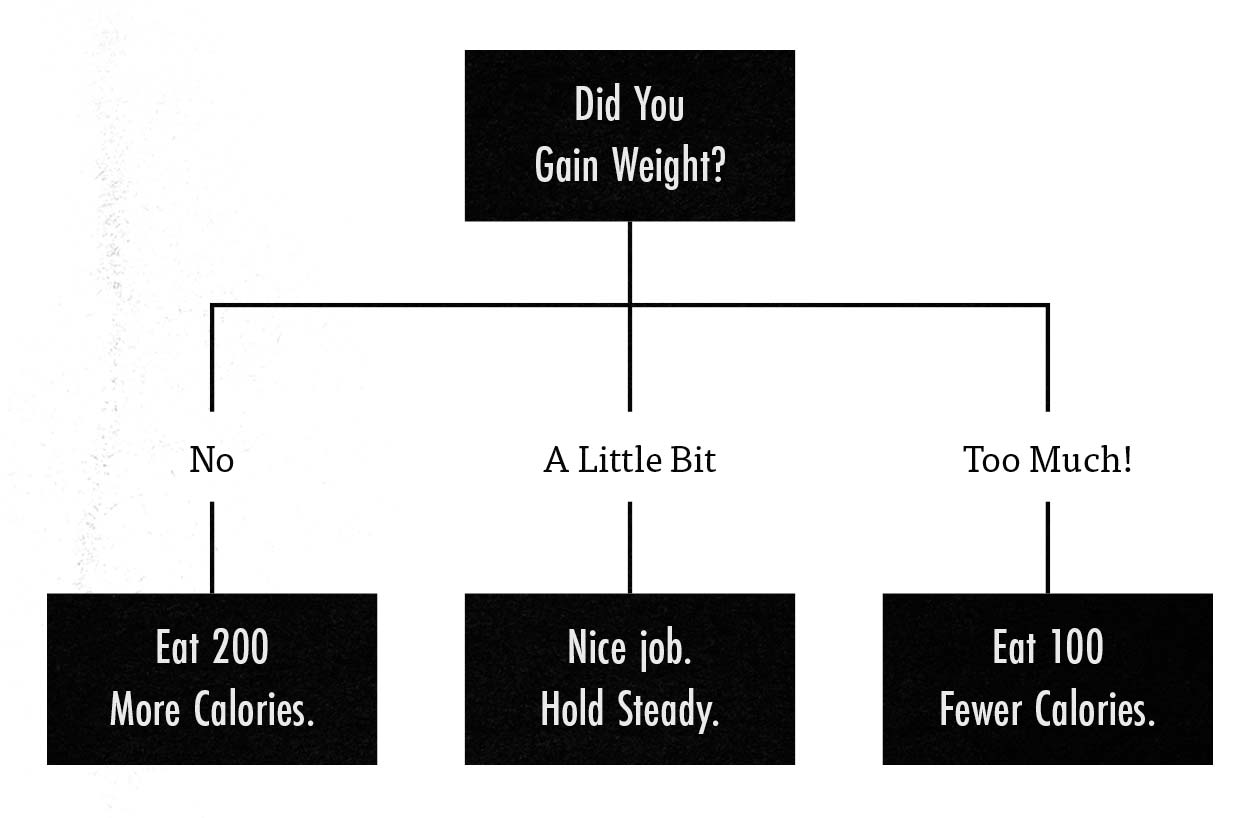
Remember, to get results, you need progressive overload in both your workout routine and your diet. That usually means gradually eating more calories to continue building muscle. That’s why it’s so important to weigh yourself and then adjust accordingly. That’s how we build a self-correcting system.
How to Eat a Nutritious Bulking Diet
Eating Enough Protein
Some research shows that you can maximize your rate of muscle growth with as little as 0.7 grams of protein per pound of body weight per day. If you weigh 130 pounds, that means eating at least 91 grams of protein per day. But nutrition labels often exaggerate the protein contents of foods, we often leave a bit of food uneaten, and most people make mistakes when estimating their protein intake. And besides, 0.7 grams per pound is the minimum amount of protein. There’s absolutely no harm in going higher.
To build in a bit of leeway, we recommend aiming for a full gram of protein per pound per day. So if you weigh 130 pounds, aim for around 130 grams of protein every day.
Eat Some Protein at Every Meal
Every time you eat protein, you’ll stimulate a little bit of muscle growth. It’s not a super huge deal. It’s nothing compared to the amount of muscle stimulation you get from working out. But it can still help. If you want to maximize your rate of muscle growth, it’s best to eat at least 4 meals per day, each containing at least 20–30 grams of protein.
Use Protein Powder as Needed
There’s nothing special about protein powder. It’s just protein in powdered form. But eating enough protein is an important part of building muscle. If you aren’t getting enough protein from whole foods, feel free to supplement with protein powder.
Whey protein isolate is a good default. It’s the industry standard for a reason. It has a nice mix of amino acids, and most people are able to digest it fairly easily. If you’re drinking protein shakes or bulking smoothies, whey is great.
Casein is good for mixing with food, especially if you’re cooking it. That’s why bodybuilders add casein to their cookie dough and oatmeal. It digests more slowly, too, making it a good protein source to have before bed.
If you eat a plant-based diet, get a blend of different protein sources. You might find a mix of pea and rice protein, for instance. That way you get a nice mix of different amino acids. For more, we’ve got a full article on plant-based supplements.
Eating Enough Carbs
Carbohydrates are amazing for building muscle. Your body breaks down carbs into glucose, which is then stored in your muscles as glycogen. This glycogen is fuel. The more of it you have, the bigger and fuller your muscles will look and the better they’ll perform. That’s why most bodybuilders and athletes get around 50–60% of their calories from carbs. That’s why most research suggests that eating more carbs will help you build muscle faster (study, study).
With that said, most people already eat plenty of carbohydrates. You might already be getting 50–60% of your calories from carbs. So you don’t necessarily need to eat more carbs. Here’s how to think about it:
- Eat enough protein—around a gram per pound bodyweight per day. That will probably be around 20% of your daily calories. That’s probably more than you eat right now. Most people need to add protein to their diets.
- Eat plenty of carbs—around 50–60% of your daily calories. You might already eat this much. It depends.
- Fill in the rest with fat—around 20–30% of your daily calories. You may already be eating too much.
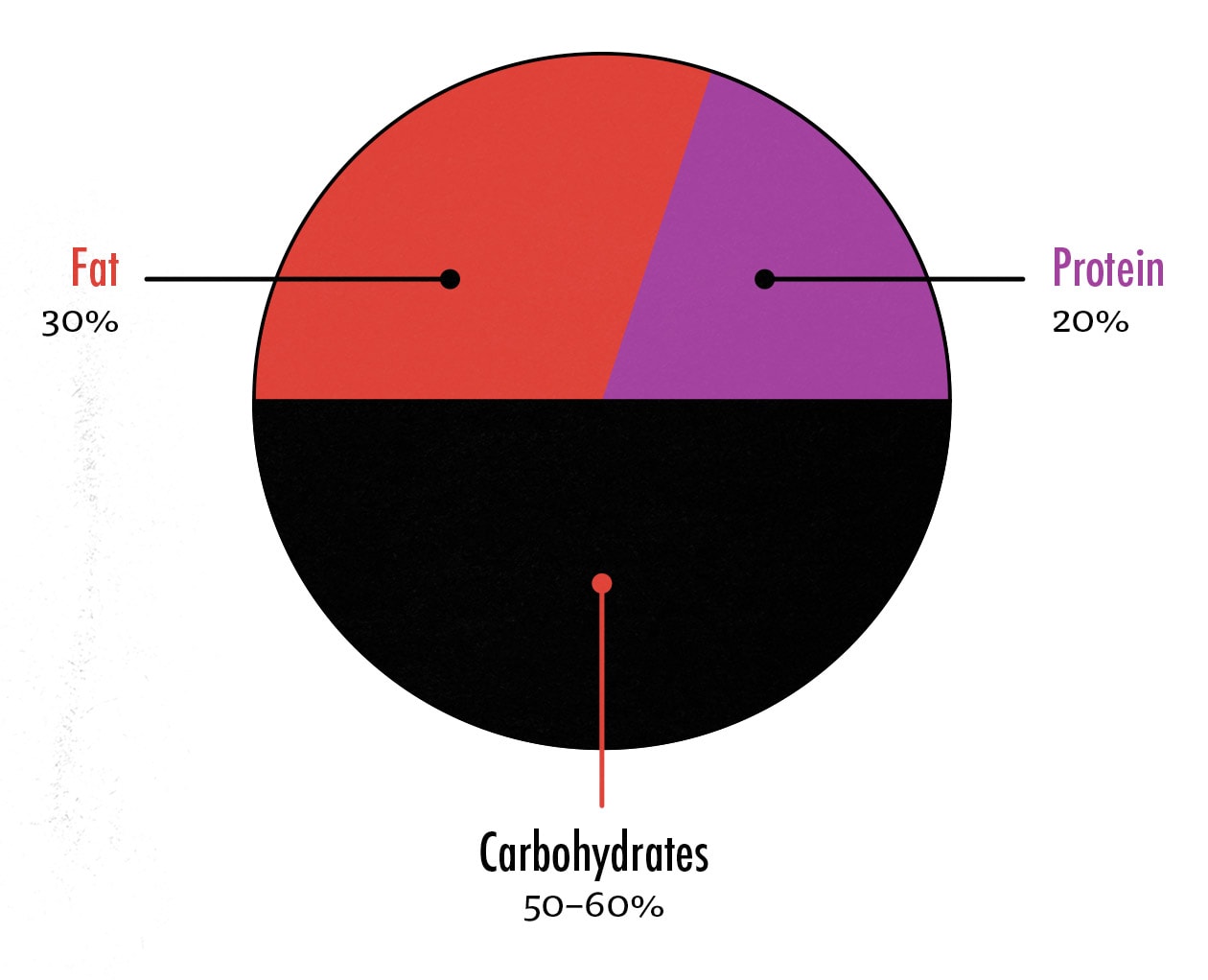
When picking your carbs, think of fruits, veggies, legumes, dairy, and starches. Foods like bananas, potatoes, beans, lentils, yogurt, oats, and rice are all super popular with bodybuilders. Broccoli and spinach are carbs, too, of course. It’s just that they don’t contain many calories. That’s why people lean into the sugary, starchy carbs when trying to build muscle.
Here’s the thing: if you’re overweight, you have a big stomach, and you struggle with eating too much, lean into carbs that are more filling and contain fewer calories. Choose carbs with more fibre and water. Boiled or baked potatoes, fruits, oatmeal, broccoli, salads, and so on. And try not to cook them in oil. But if you have trouble eating enough food to gain weight (like me) you might want to lean into carbs that are easier to eat more of. Think of homemade french fries, white rice, bananas, bread, (skim) milk, yogurt, and so on.
Eating Enough Good Fats
You need to eat fat to maintain healthy hormone levels. Fat is also where you get your fat-soluble vitamins: A, D, E and K. So it’s definitely an important part of your diet. It’s just that you might already eat enough. Fat tastes good, so people get a lot of it from processed foods, eggs, dairy, meat, chocolate, and so on. So instead of thinking of eating less fat, you might want to think of eating good fats.
Everyone is a bit different. I have a family history of heart disease, so I try to get most of my fats from seafood, nuts, avocados, eggs, and extra-virgin olive oil. Those foods contain a fairly balanced mix of saturated, monounsaturated, and polyunsaturated fats. And then in moderation, I eat cheese, yogurt, and leaner cuts of meat, which contain proportionally more saturated fat. My goals are to get most of my fat from whole foods and to keep my saturated fat intake to around 1/3 of my total fat intake.
Depending on your genetics, your tolerance for saturated fat may be different from mine. You may have more leeway. Maybe you don’t need to watch it as much as I do. But even so, you might want to think of getting more of your fat from seafood, nuts, seeds, avocados, eggs, and extra-virgin olive oil. This lines up with what most experts recommend for general health. It’s also great for building muscle.
If this sounds complicated, don’t worry about it too much. You don’t need to track your carb or fat intake. As long as you’re eating enough food, you’re eating mostly whole foods, and you’re eating enough protein, you’ll do great.
Eating Often Enough
Every few hours, you have an opportunity to trigger a bit of muscle growth by eating a meal that contains some protein. That means you’ll build muscle a bit faster by eating 5 meals per day than you would by eating 2. But if you bump that up to 9 meals per day, it won’t give you any extra benefit. After all, you can only trigger muscle growth every few hours. If you eat more often than that, it won’t give you any extra muscle growth.
With that said, eating often won’t boost your muscle growth by all that much. If you prefer eating 3 meals per day, that’s fine. You don’t need to force yourself to eat any extra meals. And if you do, it’s okay if those extra “meals” are snacks—something like a protein bar, a bowl of Greek yogurt with frozen berries, some cottage cheese with a spoonful of strawberry jam, or a handful of trail mix. These don’t need to be full meals. They just need to contain at least 20 grams of protein.
The main benefit of eating more often is that it makes it easier to eat more calories. You won’t need to eat such large meals. You won’t need to pack your stomach so full. That’s why bodybuilders eat so often. It’s not just to build more muscle, it’s also to manage their appetite, maintain higher energy levels, and avoid acid reflux.
Resting Enough to Build Muscle
Rest is the final pillar. First, you lift, then you eat, and then you rest. Now, just to be clear, you could build muscle without paying much attention to rest. Plenty of people do. Maybe they stay up late reading Alexandre Dumas but still wake up at the crack of dawn to squeeze a workout in before work. That work ethic can pay off. They’ll get results. But they’d build even more muscle if they got more rest. They’d gain less fat, too. And they’d be healthier.
We’ve already written about rest days and recovery times. And the sample workouts we’ve given aren’t overly intense. If you follow those routines, there’s plenty of rest built-in. So in this section, let’s talk about the celestial emperor of rest: sleep.
Getting enough sleep is powerful for a few obvious reasons. The more sleep you get, the more willpower, motivation, and energy you’ll have. That can make it easier to do your workouts, give each set your best effort, and stick to a good muscle-building diet. If you’re a beginner, getting more sleep can also help with motor learning. You’ll do a better job of improving your exercise technique from workout to workout. That’s already reason enough to prioritize sleep. But it gets better.
The more you sleep, the better your hormone profile will be for building muscle. You’ll have more testosterone and less cortisol. You’ll have greater insulin sensitivity and lower levels of inflammation. And more of the food you eat will be directed to muscle growth instead of fat storage.
How Sleep Affects Muscle & Fat Gain
In a study by Jabekk et al., they split 30 men up into two groups. All of them were put on a weight lifting program but only half were given instructions about how to improve their sleep. Keep in mind that these were just instructions. They weren’t given medication or monitored during the night or anything. They were just told how to improve their sleep.
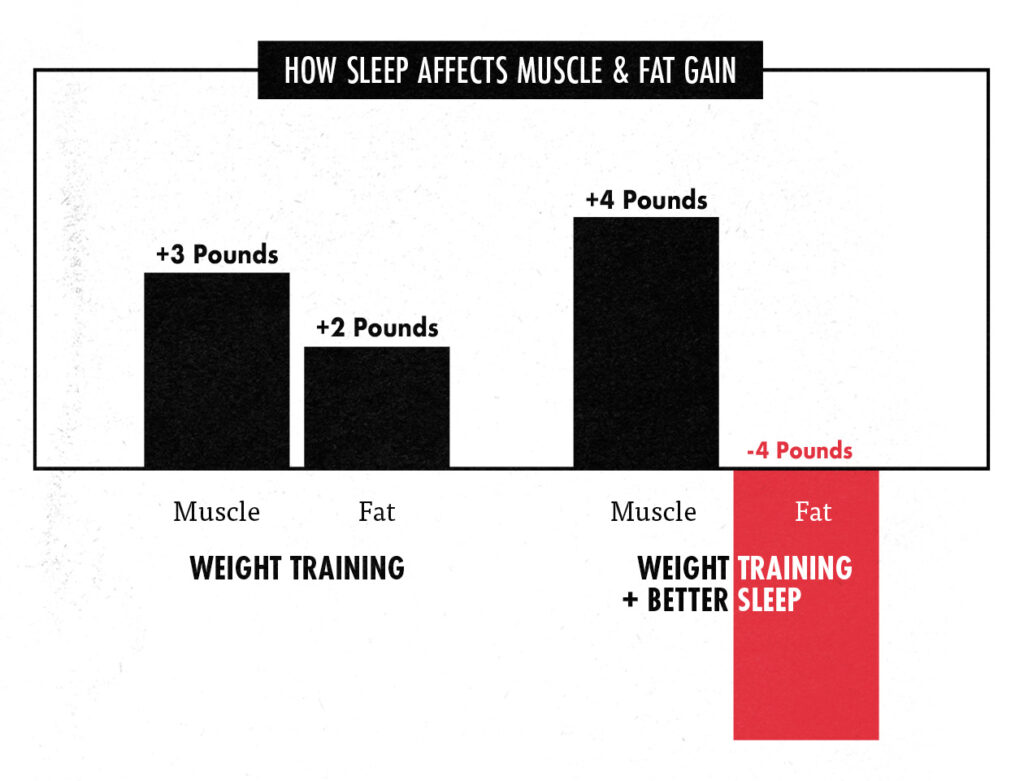
The weight training group did pretty well. Weight training is a powerful muscle-building stimulus. But the group that was taught how to improve their sleep gained around 30% more muscle while simultaneously losing 4 pounds of fat. This makes sleep one of the very best ways to improve your results. More muscle, less fat. It doesn’t get much better than that.
How to Improve Your Sleep
There are two aspects of sleep you need to focus on: length and quality. First and foremost, you need to get to bed on time. You need to give yourself enough time to sleep. Around 7–9 hours is enough for most people. If you’re unsure how much you need, better to err on the side of getting more. Go to bed 9 hours before you need to wake up. Then wake up when you feel ready for it. If you wake up before your alarm clock, great. Adjust from there.
Some people might need to be strict with their bedtimes. Maybe at 9 PM, you lower the lights. Maybe at 10, the screens go off. Maybe at 10:30, you brush your teeth and head to bed with a good novel. Here in the Caribbean, school starts super early. My son wakes up a little after 6 so that he can head off to school at 7:15. My goal is to wake up—without an alarm clock—before he does.
Getting to bed around the same time every night also establishes a steady circadian rhythm. You’ll get into the habit of waking up, eating your meals, and going to sleep at the same times every day. You’ll have more energy in the morning, more of an appetite for your meals, a smoother time digesting those meals, and an easier time falling asleep at night.
Sleep quality is a bit trickier. The most important thing is to reduce stress, especially near your bedtime. If you’re feeling relaxed, you’ll be able to slip more easily into a deep and restful slumber. Getting some sunlight in the morning can help. So can switching to dimmer, redder lights at night. It also helps to do something laid back in the evening, like reading an engaging novel or watching TV with your spouse. (If you watch TV, you might want to dim the backlight and/or get some amber-tinted glasses.)
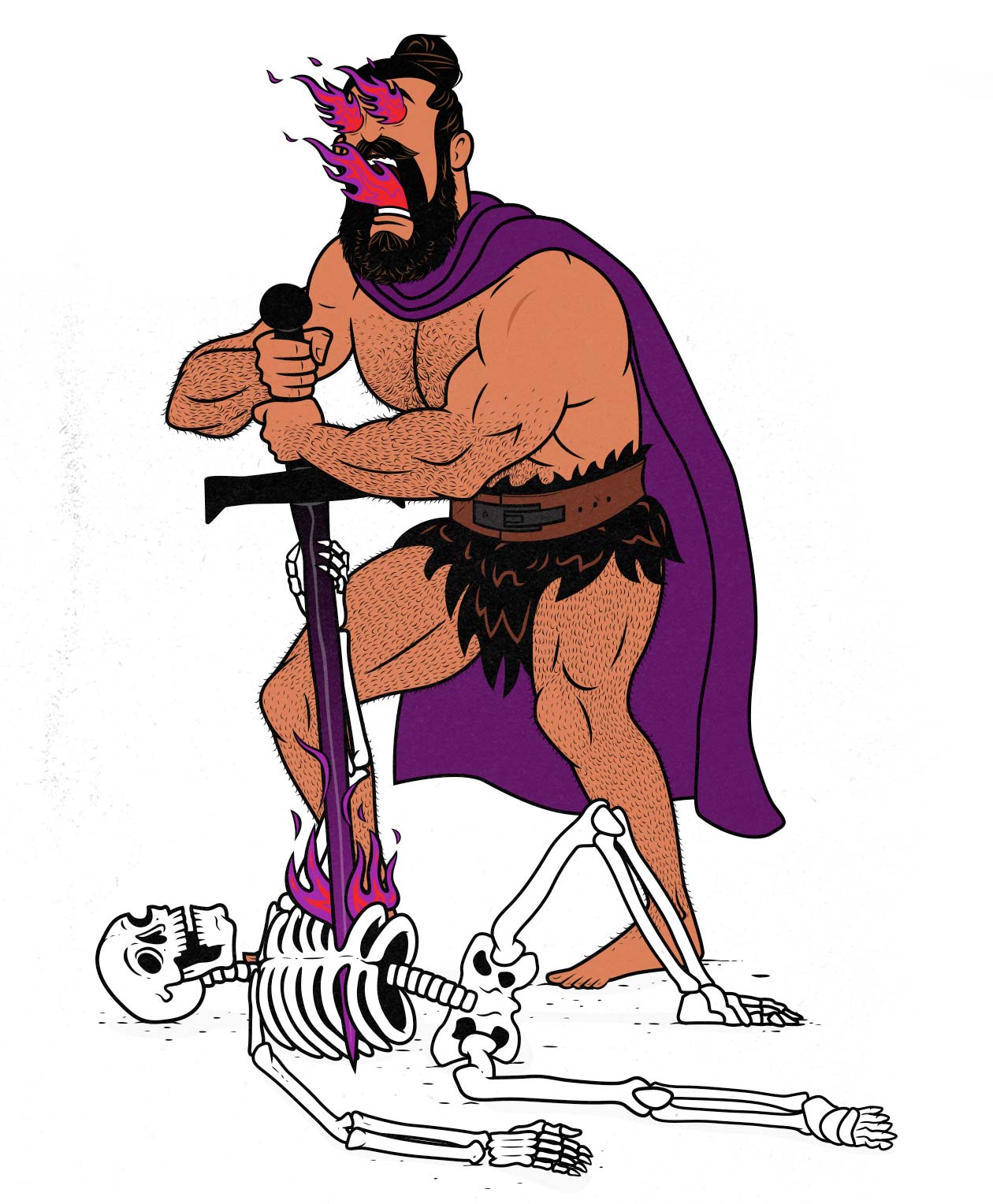
For me, that isn’t enough. Whenever I lie down to sleep, I have a million ideas racing through my mind. So I bring a book up to bed, turn on a dim amber reading light, and read until I can’t keep my eyes open anymore. It can’t be just any book, either. Non-fiction gives me ideas. Horror isn’t relaxing. Thrillers are too thrilling. It needs to be some sort of novel that gets me caught up in its escapist narrative. So I usually read fantasy. After ten minutes of reading Mike Shel, I’m peacefully dreaming of slaying skeletons. Everyone is a bit different, though. Perhaps you prefer gunning down alien arachnids. Or listening to a podcast. Whatever you find relaxing.
For more, we have an article about min-maxing your sleep routine.
Active Recovery
Okay, now that we’ve gone over the importance of sleep, there’s one more aspect of rest we should cover: active recovery. This is the idea that the best way to recover between workouts is to continue being at least somewhat active. Instead of alternating between lifting weights, eating sumo stew on the couch, and sleeping like a beast, it can also help to spend some time on your feet, walking around.
If you go on a walk after eating a big meal, it can help with your digestion. You won’t feel as tired and sluggish. You’ll be ready to eat again sooner. That can make it much easier to keep up with your muscle-building diet.
You could, of course, do light exercise or cardio. Some people like biking or jogging or playing sports. Those are all great options. But walking is easier. And if you’re new to working out, easier is better. Walking doesn’t require much skill, it won’t drain much willpower, and it won’t make you feel tired or sore. If anything, getting into the habit of walking should improve your overall energy levels. And it’s very, very good for your health.
Here are some goals to work towards:
- Getting at least 7500 steps per day seems to be good for general health. You could buy a pedometre and track your daily steps. You don’t have to, though.
- If you have a sedentary lifestyle, try spending 40 minutes per day walking. If you’re having trouble digesting your meals, maybe that’s a 15-minute walk after breakfast, a 15-minute walk after lunch, and another 15-minute walk after dinner. Or maybe you go on a single, 40-minute walk while you listen to a podcast every morning before work. In my case, I walk the dog with my 3-year-old son before I start work and after I finish.
So if you’re working out 3x per week, you’re desperate to build muscle, and your rest days are making you antsy, go on a walk. Or if your big bulking diet is weighing you down, get up and walk it off. You’ll feel better afterwards. And you’ll build a ton of muscle.
Living a Healthy Lifestyle
Myriad other small factors can help you build muscle, most of which fall under the loose category of living a generally healthy lifestyle. For example, we haven’t mentioned that you should be eating some fruits and veggies every day. Eating more fruits and veggies might help you build muscle more quickly, and it might make you feel less sore and inflamed, but to be honest, it’s probably not a crucial factor. It’s something you should do because it’s part of being healthy. Any benefits to muscle growth are just a nice bonus.
There are a number of things that can make your lifestyle better:
- Be active, play sports, do cardio, or go on walks.
- Go outside and get some sunshine (without overdoing it).
- Manage your overall levels of stress. And if you can’t, try not to stress about it.
- Get at least 80% of your calories from whole foods.
- Eat several servings of fruits and veggies every day.
- Limit your alcohol intake to 1–2 servings most days.
- Don’t smoke or race motorcycles.
If you can do all of these things, you might build muscle a bit faster and more leanly. Not in a major way, but perhaps in a minor way. And if you have all of these factors adding up, the differences might become meaningful, especially over a long period of time.
For instance, eating a good diet might make you feel better, improve your motivation, and give you more energy in the gym. It’s also possible that eating more veggies will give you better muscle pumps, speed up muscle growth, or reduce your rate of fat gain.
For another example, managing your stress levels might allow you to sleep better, give you more willpower, and thus help you hit your protein and calorie goals more consistently.
Frequently Asked Questions
How Long Does it Take to Build Muscle?
There’s this idea in the bodybuilding sphere that men can gain around 20 pounds of muscle in their first year, 10 in their second, and 5 in their third. And then the real struggle begins. Gains get harder and harder to come by. For women, that rate of muscle growth is cut in half. The idea is that they can gain around 10 pounds in their first year, 5 in their second, and 2.5 in their third. And then they’re left fighting for any scraps they can find.
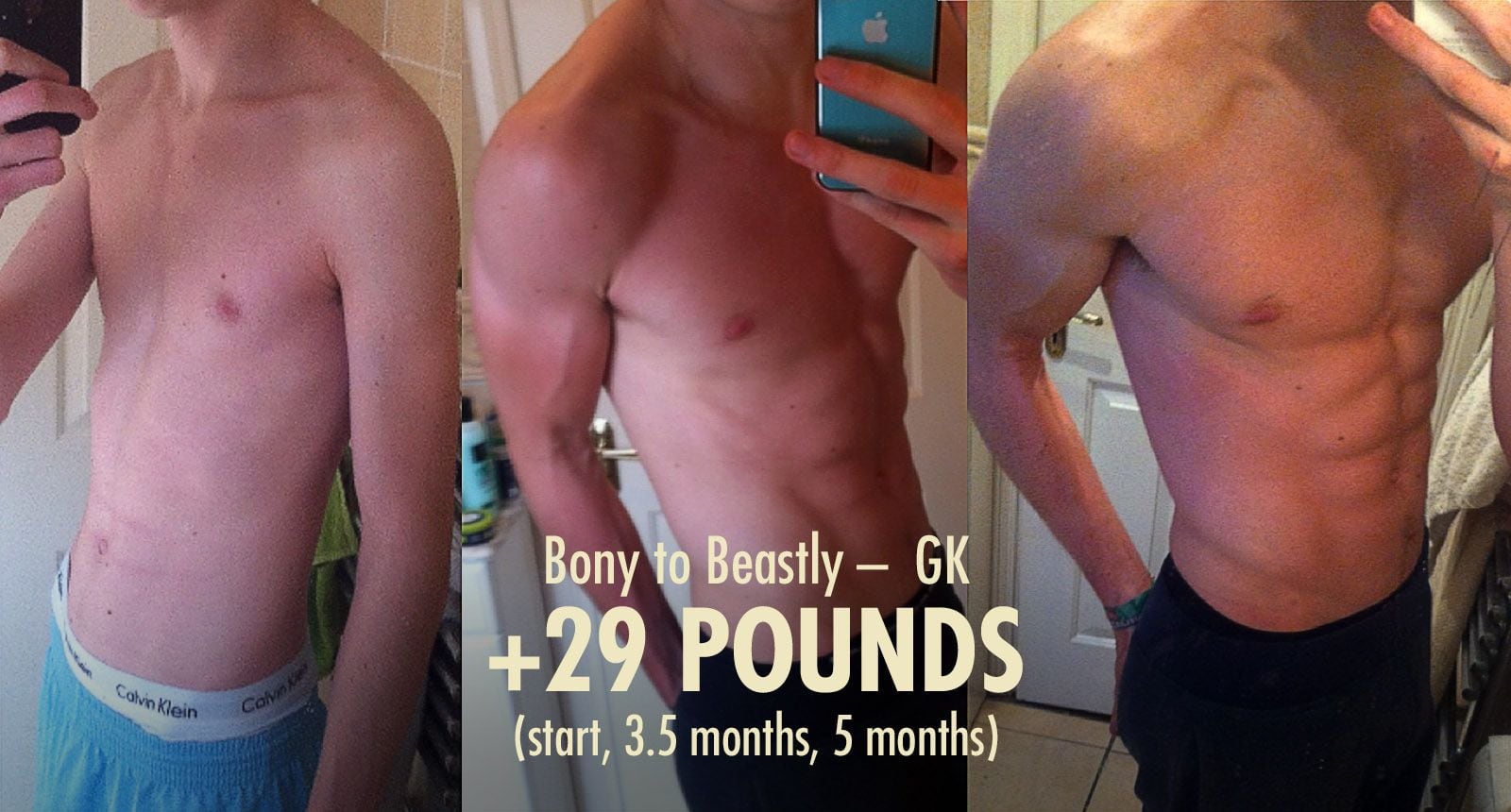
The truth is, it really depends. In our experience coaching over 10,000 skinny people, we’ve noticed that they tend to be able to gain muscle pretty damn fast. I gained 55 pounds in a little over two years. My roommate at the time gained over 40 pounds during his first year or so. My wife also gained 22 pounds in about a year.
On the other hand, you might have some factors lowing you down. If someone is overweight, they might technically be able to gain 20 pounds of muscle in their first year if they bulked. But bulking might not be the best first step for them. Maybe they’re trying to build muscle while losing weight. Maybe that cuts their rate of muscle growth in three. Maybe they only gain 5–10 pounds of muscle in their first year.
How Long Does it Take to Become Muscular?
If you train with all the wisdom of a seasoned lifter, you can probably start looking fit and athletic within a few months. For a skinny person, that might involve gaining 20 pounds of muscle fairly leanly. For an overweight person, that might mean cutting down to under 20% body fat. In either case, with just a few months of diligent work, you can get in shape and look great.
To look impressively muscular and strong, it might take around 2 years of near-perfect training and nutrition. That’s usually long enough to get around 80% of the way to your genetic potential, at least in the muscle groups that you’re doing a good job of training.
The problem is, most beginners are beginners. It takes them some time to learn the ropes. It takes most people a couple of years to look athletic and a few years to look impressively strong.
Plus, people like to take breaks. I bulked in 20-pound chunks. I would bulk, take a break for 6–12 months, do another bulk, and then take another break. During those breaks, I’d keep lifting and eating well. I’d just take a break from following a strict workout program and eating in a calorie surplus. And even with those breaks, I still managed to gain 55 pounds in two years. Not because I’m a wizard. Just because I was very skinny. So it all depends.
How Can You Build Muscle Faster?
The best way to stimulate muscle growth is to follow a hypertrophy training program and to focus on progressive overload. That’s the fastest way to stimulate muscle growth. We taught you exactly how to do that earlier in the article. Nothing is more powerful than hypertrophy training.
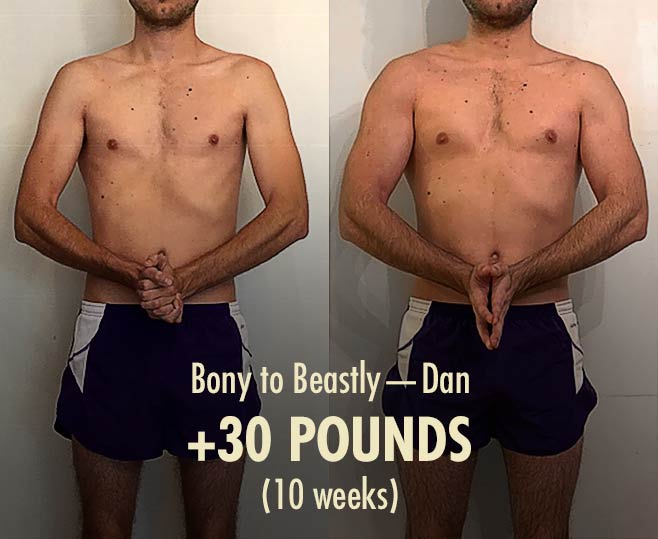
But you also need to “eat big to get big,” especially if you’re lean and skinny. You’ll build muscle faster in a larger calorie surplus. If your goal is to absolutely maximize your rate of muscle growth, you’d want to be gaining as much as 1–2 pounds every week. Just remember that you’ll probably also get fat. And if you want to get rid of that fat, you’ll need to eat in a calorie deficit. And while you’re in that deficit, you won’t be building muscle.
For most people, especially if you aren’t super skinny, it’s better to build muscle at a moderate pace. Stimulate a maximal amount of muscle growth with your workouts, but gain more like 0.5–1 pound per week. That’s still 10–20 pounds within the next 5 months. That’s a lot of muscle!
Can You Build Muscle Without Gaining Fat?
Gaining weight leanly ultimately comes down to the five principles we’ve mentioned above:
- Train for muscle size: the better your workout program is, the more muscle growth your training will stimulate, and so the more of your calories will be directed towards muscle growth, making your gains leaner. This is why hypertrophy training is so important.
- Eat enough—but not too much: another way to keep your muscle gains leaner is to slow down the rate with which you’re building muscle. If gaining a pound per week is resulting in noticeable fat gain, try removing 200 calories from your diet, aiming to gain 0.5 pounds per week instead. If that’s still resulting in noticeable fat gain, try gaining weight even slower.
- Eat enough protein: one of the main factors that can limit our rate of muscle growth is protein. If we aren’t eating enough protein, our bodies won’t be able to build muscle at full speed, and so more of the weight we gain will be fat. That’s why it’s so important to make sure you’re eating 0.8–1 gram of protein per pound bodyweight per day while gaining weight.
- Get enough good sleep: as we’ve covered above, getting enough sleep is an important part of maintaining healthy hormone function, having enough energy to train hard, and reducing our levels of chronic stress. If we can get in the habit of getting enough good sleep each night, our muscle growth will be faster and leaner.
- Live a generally healthy lifestyle: when trying to gain weight leanly, it’s important not to miss the forest for the trees. Training for muscle growth is important, but we also need to make sure that we’re also getting up during the day and moving around, getting outside, being active. Eating enough calories and protein is important, but we also need to make sure that our diet is mostly real, whole foods. Getting enough protein is important, but maybe don’t get all of it from powders—include some meat, dairy, eggs, nuts, peas, and legumes.
Other factors can impact how lean our gains are. For instance, if you’re gaining weight on a ketogenic diet, your glycogen stores won’t be as high, maybe you won’t be able to build muscle quite as quickly, and maybe slightly more of your gains will be fat. Or if you’re gaining weight while intermittent fasting, your protein distribution won’t be as good, maybe you won’t build muscle quite as quickly, and so maybe you’ll gain slightly more fat. But these tend to be more minor factors. Before worrying about the details, master the basics.
If you’re having trouble gaining weight leanly, we have an article specifically for skinny guys with belly fat.
What are the Best Foods for Building Muscle?
There’s no single best food for gaining weight. You can build muscle while eating a wide variety of diets. But even so, examples never hurt.
- Protein powders are a popular way to boost protein intake.
- Smoothies are an easy way to consume a bunch of liquid calories.
- Trail mix (nuts + dried fruit) is a healthy snack that makes it easier to gain weight.
- Milk is a simple drink that’s high in protein and calories.
- Rice is a cheap way to add carbs into your diet.
- Peanut butter and banana sandwiches are a quick muscle-building meal.
- Ground meat is easier to chew and digest than steak, making chili, picadillo, and hamburgers great for gaining weight.
- Beans and lentils (and other legumes) are a cheap source of carbs, fibre, and protein.
- Nuts are a healthy source of fats and often protein, and they’re very high in calories.
- Olive oil is one of the healthiest fats to add into your diet, and it can be drizzled on vegetables to increase their calorie content.
- Fruits make for great snacks. They’re often quite filling, but they can still be a great source of calories. Some fruits, such as bananas, are less filling than others. Others, like apples and berries, tend to be more filling.
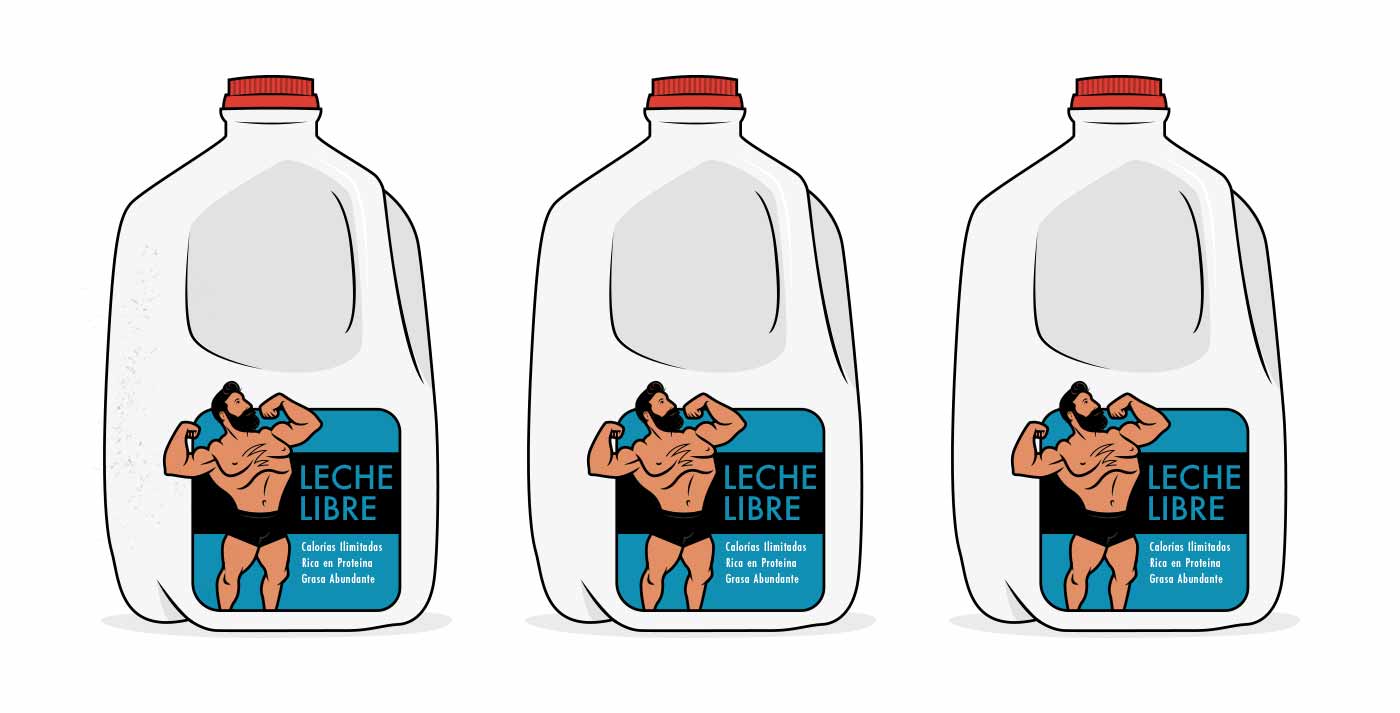
The list goes on. Some people might bulk with curries instead of chili, tacos instead of sandwiches, or prefer to bulk on a plant-based diet. That’s all perfectly fine. Most whole foods are good for building muscle in one way or another, so don’t get too hung up on the specifics. Potatoes or rice? Tortilla or bread? Go with your gut!
For more, we’ve got a full article on the best bulking foods.
What Are the Best Supplements for Gaining Muscle?
Supplements aren’t that important. You don’t need them to build muscle. And even the very best ones aren’t that effective. Still, they can help. Protein powders make it easier to eat enough protein, caffeine can give you the energy to get to the gym, and creatine increases your rate of muscle growth by around 33%.
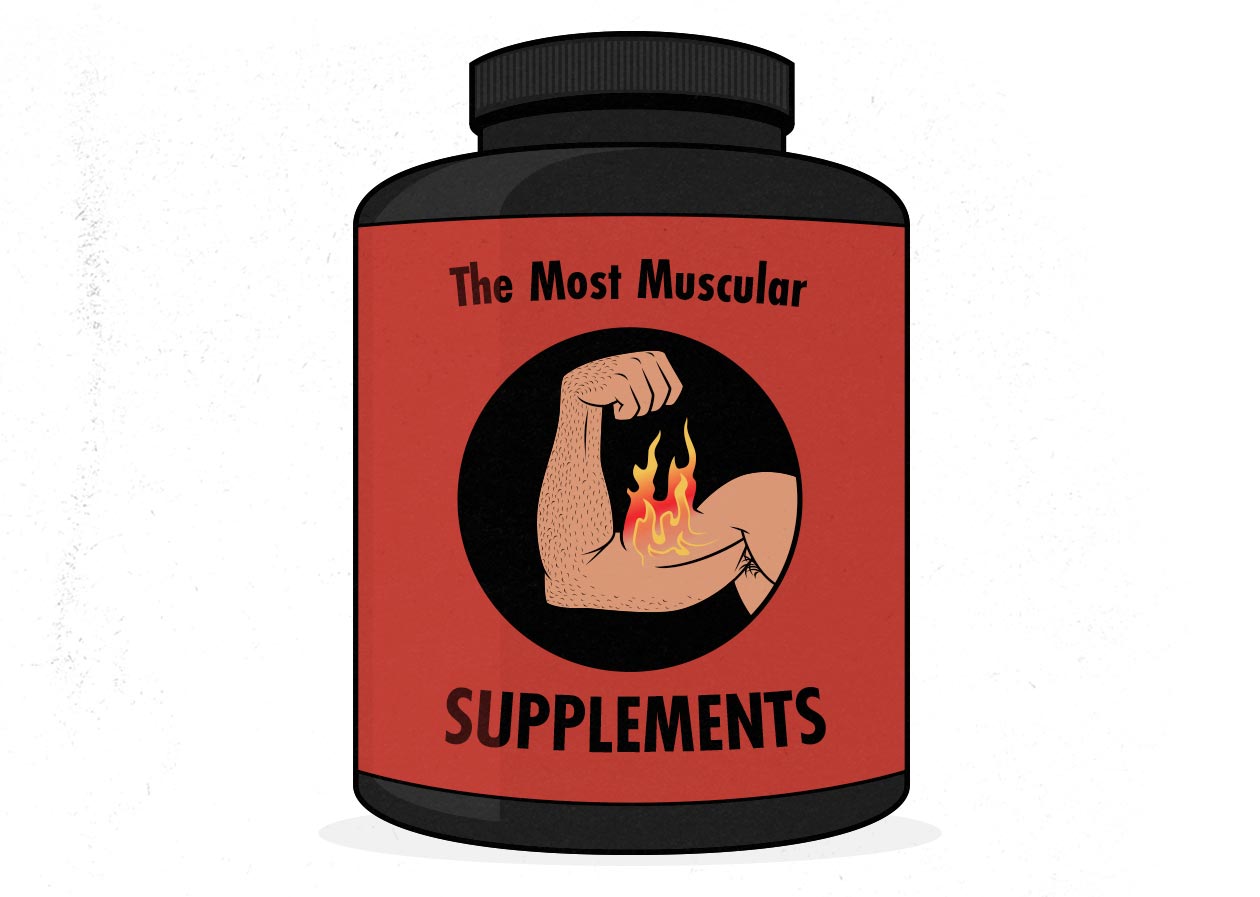
Diving deeper down the rabbit hole, there’s some evidence for beta-alanine for wringing out more reps in higher rep ranges, citrulline malate for getting a pump, ashwagandha for relaxation, and a dozen other supplements that probably won’t have much impact. But if you buy some sort of pre-workout or blend, you’ll see them listed there. And that’s okay.
Weight gainers are also popular, especially for skinny people who are having a hard time eating enough. They’re made from protein powder, carb powder, and a bunch of flavourings. Just remember that they’re heavily processed, and so they shouldn’t make up a large portion of your diet. Instead of eating 1,250-calorie servings, maybe cut that in half, eating more like 600 calories per serving. And even then, blending up some bananas, oats, frozen berries, and Greek yogurt is probably better.
Should Skinny Guys Build Muscle Differently?
Helping skinny guys build muscle just so happens to be our specialty. We’re naturally skinny guys ourselves, we’ve each gained over 60 pounds at under 12% body fat, and we’ve helped over 10,000 skinny people bulk up. We have a full muscle-building program made specifically for skinny guys, and we have an entire blog for skinny guys, too.
Long story short, skinny guys build muscle the same way as everyone else. The principles remain the same. We should still be focusing mainly on doing 6–20 repetitions per set, 3–8 sets per muscle per workout, and training those muscles 2–3 times per week. We still need to eat enough protein, eat enough calories, and get enough good sleep.
The main thing that sets skinny guys apart is that we often need to eat more calories to gain weight, our metabolisms often adapt more readily to those higher intakes, and we often find it harder to fit those calories into our stomachs. This can make it harder to gain weight. If you’re having trouble gaining weight (as we did), here’s our article on how to eat more calories.
Should Women Build Muscle Differently?
The best way for a woman to build muscle is to do hypertrophy training, eat enough protein, eat enough calories, and get enough sleep. The principles are the same for men, women, and everyone in between. However, women do have slightly different strengths and limitations, at least on average. Women can also have different goals.

When it comes to muscle-building goals, it varies, but our female clients are often more interested in building bigger glutes and thighs, less interested in building a thicker neck. That means that women might want to spend more time doing squats, Romanian deadlifts, and hip thrusts, less time doing neck curls. Is that because men and women build muscle differently? No, it’s just that you should customize your workout routine to match your goals.
When it comes to strengths, women are often better at lifting in higher rep ranges, recover more quickly between sets, and can handle higher training volumes. In this article, we’ve given ranges, talking about doing 6–20 reps per set, 3–8 sets per muscle per workout, and resting 2–5 minutes between sets. You might favour the higher ends of those ranges.
- You might want to use higher reps. For instance, you might prefer doing 10 reps on your big compound lifts instead of 6 reps. Or doing 20 reps on your isolation lifts instead of 12.
- You might want to do more sets for your target muscles. For instance, doing 3 sets of squats, 3 sets of Romanian deadlifts, and 2 sets of hip thrusts, yielding 8 sets for your glutes every workout.
- You might want to use shorter rest times. Women tend to recover faster between sets. So instead of resting 2–5 minutes between heavy sets, you might only need to rest 1.5–3 minutes.
- You might love circuits and supersets. Women are often able to handle denser workouts without being limited by their cardiovascular systems. You might want to superset your exercises together, such as doing a set of squats, resting a 30–60 seconds, doing a set of push-ups, resting another 30–60 seconds, and then going back to squats. That way you’ll be able to fit more work into a shorter period of time.
Most women have stronger lower bodies relative to their upper bodies. When you’re doing deadlifts, your grip or back might give out before you’ve challenged your glutes. That can make it hard to stimulate muscle growth in your lower body. If you want to use the deadlift to stimulate muscle growth in your hips, then, you might want to choose a variation where you aren’t limited by your upper-body strength. Maybe that means doing Romanian deadlifts with lifting grips (like Versa Gripps) instead of doing conventional deadlifts with a mixed grip. Maybe you want to choose some lower-body lifts that won’t challenge your upper body, too. Hip thrusts and glute bridges are great for working your hips without taxing your upper body.
These are generalizations, though. The trick is to start training, see what your body responds best to, and then lean into what’s working.
How Can You Build Muscle If You’re Skinny-Fat?
Skinny-fat people aren’t underweight or overweight. But they are under-muscled and over-fat. If you’re skinny-fat, it means you’ve been eating the correct amount of food, it’s just that your diet and exercise routine both need some work.
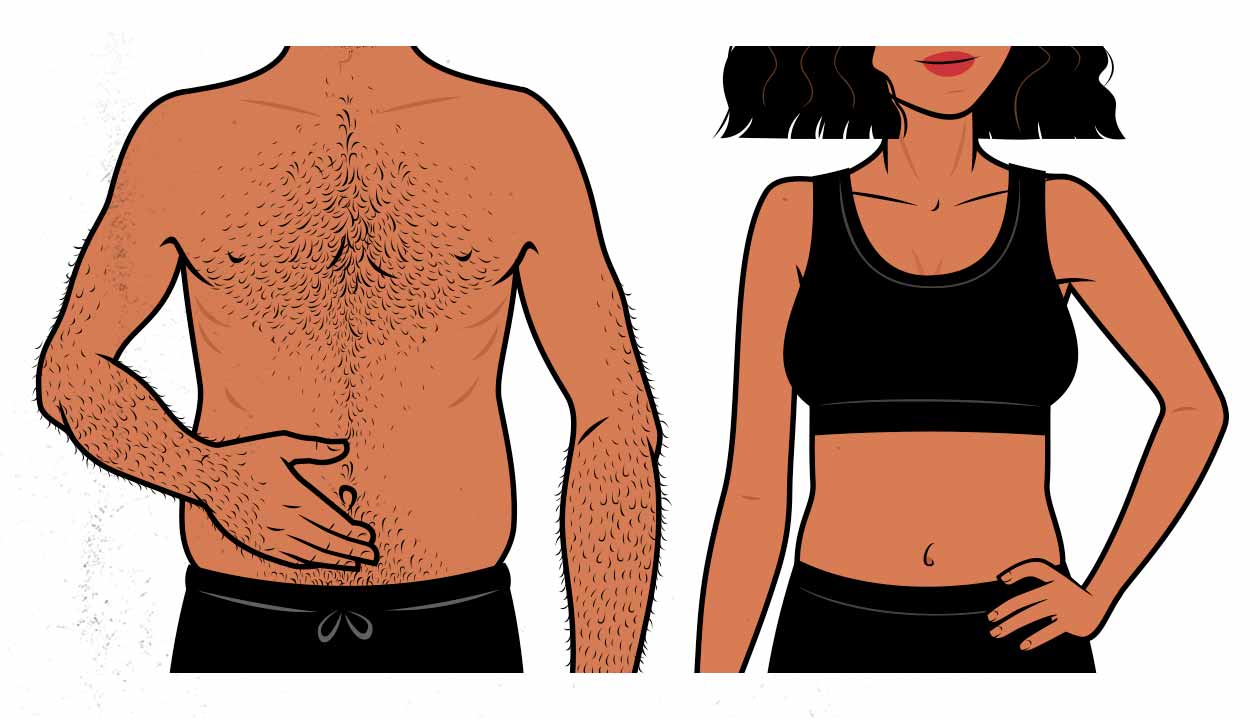
Skinny-fat people still need to focus on hypertrophy training first, then eating enough good food, then getting enough rest. The three pillars are the same. But it can also help to spend some extra time looking at the quality of your diet and the amount of activity you have in your day-to-day life. For instance, you might want to focus even more on eating more whole foods and going on a walk every day.
You may also want to “bulk” very slowly, aiming for the very bottom of the range, gaining something like 0.25 pounds every week.
For more, we’ve got a full article for skinny-fat guys and another for skinny-fat women.
How Can You Build Muscle at Home?
The easiest way to build muscle at home is to build a home gym. You’ve got two good options and one that can work in a pinch:
- Barbell home gym: f you’ve got a house with a spare room, we recommend a barbell home gym. Barbells are pleasant to train with, and they make it super simple to progressively overload your lifts. They’re amazing for building muscle. Here’s our guide on how to build a barbell home gym.
- Dumbbell home gym: If you don’t have space for a barbell home gym, the next best option is to get some adjustable dumbbells. Dumbbells are great for building muscle, especially for beginners, and especially in your upper body. In fact, for some muscle groups, such as your biceps, triceps, and chest, dumbbells often make it easier to stimulate muscle growth. Here’s our guide for building a dumbbell home gym.
- Bodyweight training: if you can’t afford a home a home gym, you can start with bodyweight training. It’s harder, more complicated, and it can get pretty painful, but it works. Here’s our bodyweight hypertrophy training guide.
Just remember that as you go down the list, things get a bit harder. Training at a commercial gym gives you access to every piece of equipment. Barbell home gyms don’t have everything, but the workouts tend to be short, efficient, and fairly painless. Dumbbell workouts are a bit longer and harder, but they’re still just as good for building muscle. And bodyweight workouts are so annoyingly painful that most people eventually find the money to get a gym membership or buy some weights.
Can You Build Muscle Without Weights?
If you don’t have access to barbells or dumbbells, a common alternative is to use resistance bands. It’s true that resistance bands can stimulate muscle growth, but they give most movements a fairly poor strength curve, meaning that the range of motion is difficult in the wrong places.
If you don’t have free weights, it’s often better to do bodyweight training instead of using resistance bands. With bodyweight workouts, most lifts are still the most challenging when our muscles are in a deep stretch, which is great for stimulating muscle growth. As a result, you can still build muscle comparably fast, especially in your chest and shoulders. It’s just harder and more painful than using free weights.
For more, we have a full article on bodyweight hypertrophy training.
How Can Vegans Build Muscle?
Vegans can build muscle comparably well to everyone else (research breakdown), it just means being a bit more focused on getting enough protein and micronutrients. That’s often as simple as supplementing with plant-based protein powder, DHA from algae, and some vitamins.
For more, we have a full guide on how to build muscle on a vegan, plant-based diet here. We also have an article on plant-based muscle-building meals.
Conclusion
To build muscle, you need to challenge your muscles (lift enough), eat enough food to fuel muscle growth (eat enough), and give your muscles time to repair and grow (rest enough). A good night’s sleep will help you consolidate your learning, replenish your energy, and keep your hormones flowing strong. That gives you a clear sequence to follow:
- Lift enough: the first and most important part of stimulating muscle growth is resistance training. The best type of resistance training for building muscle is hypertrophy training. You can build your own routine from scratch, but we’ve given some sample beginner routines above.
- Eat enough: after you’ve started working out, you need to eat enough calories and protein to fuel muscle growth. If you’re overweight, eating enough protein might be enough. 0.7–1 gram of protein per pound bodyweight per day is great. If you’re skinny or lean, you also need to make sure that you’re eating enough calories to gain at least a little bit of weight every week.
- Rest enough: after working out, you need to rest while your muscles recover and grow. There are exceptions, but most muscles benefit from at least a day of rest before they should be trained again. For beginners, that usually means doing full-body workouts 3x per week—every Monday, Wednesday, and Friday. If you have enough energy to do even more, you might want to go on walks. Finally, try to get plenty of good sleep.
Once you understand these principles, you just need to learn how to apply progressive overload to them. In the gym, you need to gradually lift heavier weights, wring out more reps, or use a deeper range of motion to continue challenging your growing muscles. In the kitchen, you need to gradually eat more food to continue building muscle. And as your routine gets heavier and your diet gets bigger, you may find that you need even more rest.
Remember that you don’t always need to be building muscle. Bulking isn’t forever. You can take deload weeks, where you scale back your workouts to encourage recovery. You can take diet breaks, where you give your digestive system a break. And when you finish 3–6 months of bulking, maybe you spend another few months in maintenance, doing easier workouts and eating according to your appetite.
Finally, as cool as it is to strive for continued improvement, remember to celebrate your wins. You don’t need to look like a bodybuilder to feel stoked about the body you’re building.
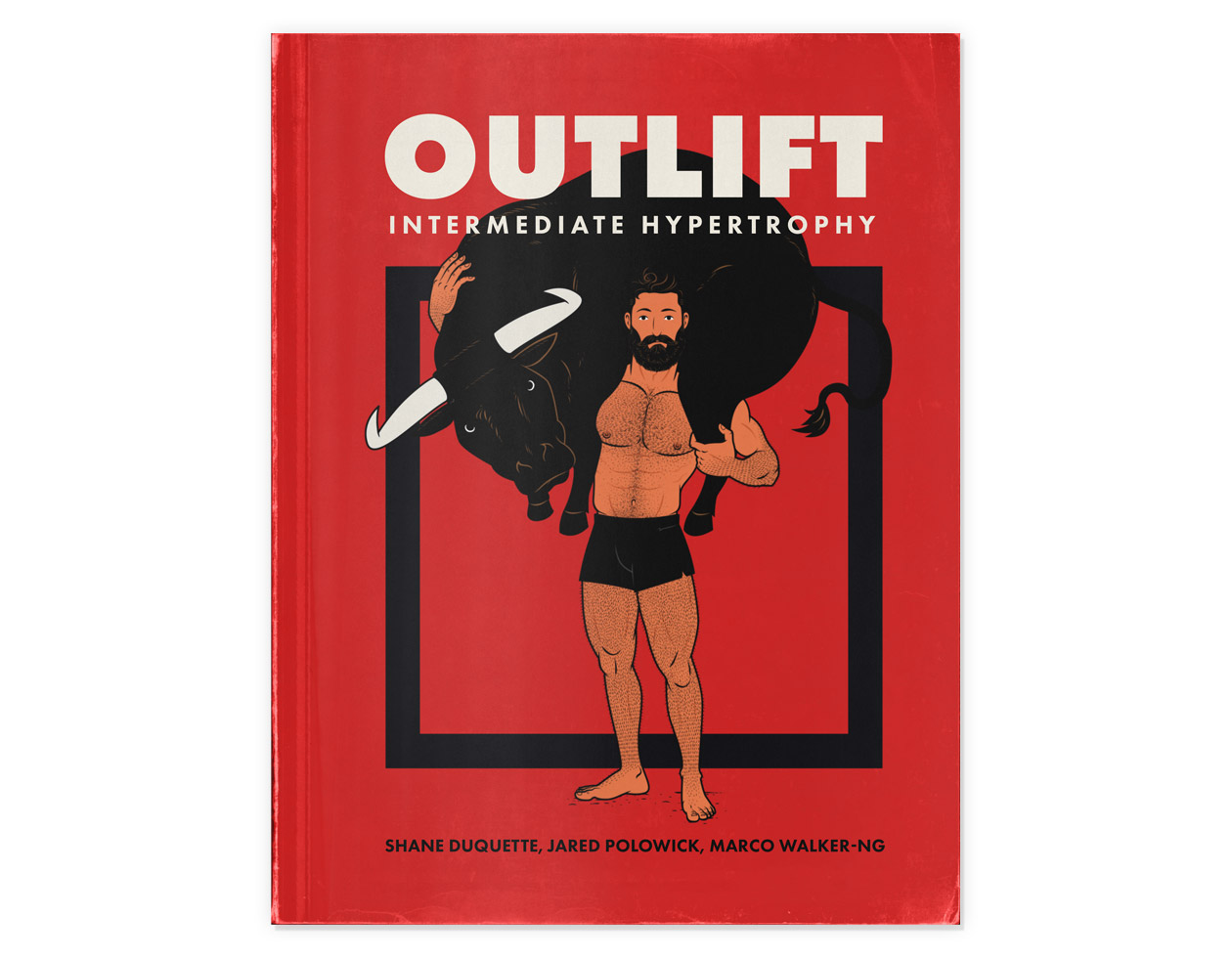
If you’re still skinny or skinny-fat, try our Bony to Beastly (men’s) program or Bony to Bombshell (women’s) program. If you liked this article, you’ll love our full programs. Our programs cover all of the principles from this article, but they also include exercise video tutorials, a recipe book, a full 6-month workout program, and coaching in our online community. In that online community, we’ll help you track your progress, adjust the workout routine to suit you better, and answer any questions you have. Perhaps most importantly, we can all support each other as we grow together.
Or, if you’re already an intermediate lifter, check out our customizable Outlift Intermediate Hypertrophy Program. It includes a full guide covering the principles of exercise selection and hypertrophy training. And it lets you build your own hypertrophy training program using dropdown menus. And if you want, you get the option to join our online coaching community.



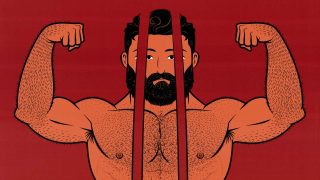
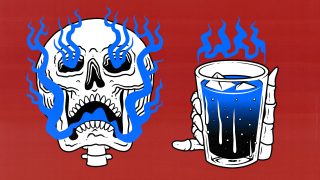
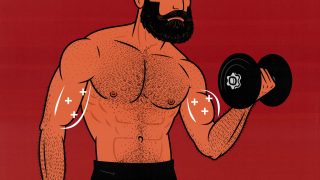
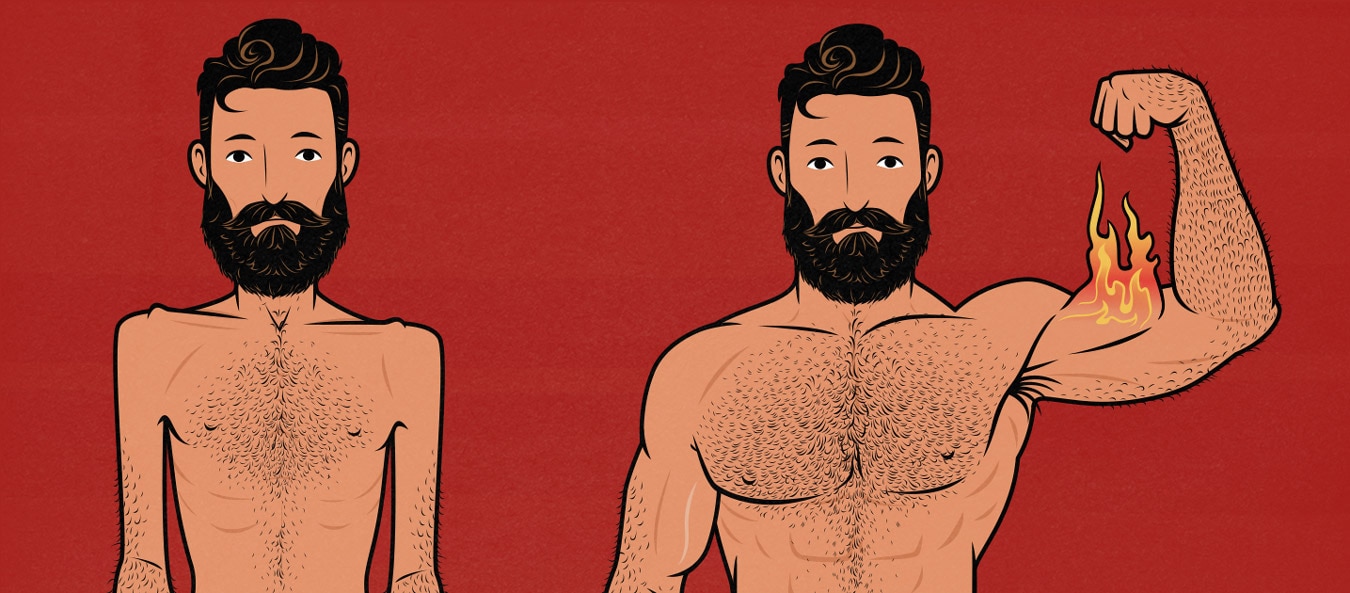
This is absolutely a game-changer worth of information! I appreciate all that you guys do. Thank you for this thorough breakdown!
Our pleasure, Nne! So glad you liked it 🙂
The passion and expertise in your writing is motivating in itself. I was on the mailing list for your posts for a few months before becoming a customer of the Outlift program. Simple and effective. I started seeing gains in growth and strength through phase 2. Started and stopped unfortunately so I just got to stay consistent. Restarting phase 2.
Keep the goods coming
Thank you so much, Christopher!
I hope you have better luck sticking with it this time around. Let us know if you need any help 🙂
Guys, I’ve been doing the intermediate program and can’t praise it enough. I’m on phase 3 and have never made these types of gains. The website is awesome too. So many great articles. Well researched. I wish it was around when I first started lifting.
I have a question about upper/lower body programming. I have naturally big legs and I’m actually having trouble fitting into my pants. Thighs, not waist thank goodness. How would I go about programming the intermediate program and focus on upper body hypertrophy and less so on my legs? I want to keep gaining strength though. Thanks in advance and keep up the amazing work.
Woot! Thank you so much, Mike. And congratulations on the gains! That’s awesome 😀
I hear ya. I’ve got naturally skinny legs, but my waist is fairly small, too. When my legs and glutes started to grow, buying pants got a lot harder.
The foundation of continued muscle growth is progressive overload, right? If you don’t want your legs to keep growing, all you need to do is stop progressively overloading them. Just stop increasing the load and reps over time. Keep doing what you can currently do. You can cut way down on the volume, too, since it’s fairly easy to maintain muscle. With a couple of sets of squats and Romanian deadlifts every week, I doubt you’ll lose any lower-body size or strength.
There’s a problem, though. You can’t really expect to get stronger if you aren’t gaining muscle size. I mean, you could improve your technique. And if you aren’t used to lifting in lower rep ranges, you could get better at that. You won’t become “stronger,” at least not in a general sense, but you might get better at testing your strength. You could learn how to optimize a low-bar squat to lift more weight for a single repetition. That kind of thing. But to actually keep getting stronger, you’d need to keep gaining muscle.
If you store fat in your legs, you might be able to shrink them down with a cut. That might free up some room for muscle growth. But for that to work, you’d need to be happy maintaining a lower body-fat percentage than you have right now. That may or may not be realistic or enjoyable.
If you’re shifting your legs to maintenance, that will free up more time and energy for your upper body. Maybe that means moving some isolation lifts to your lower-body days. Maybe you do your core and neck training on leg days. That kind of thing. Or you could do 2–3 upper-body days per week along with 1–2 lower-body days. Nothing says you need to keep them in perfect balance.
Hey guys great article at usual. I’m just wondering if your beginner program would get to $100 this Black Friday as that is the lowest my parents will let me buy it. The current price is way too expensive. I have tried to bulk unsuccessfully multiple times, and I really think this program will be what I need to get over the hump, but I just can’t afford it at the current price.
Thank you, John!
The only sale we run is our New Resolutions Sale. It’s usually around 20% off. We do have a payment plan, though. You can get it at the regular checkout. That will bring it to $20/month. Full refund policy and guarantee.
We’re also trying to publish more of these totally free, comprehensive guides. That way you don’t need to buy anything unless you want to.
Hey Shane and Marco I want to say thank you guys a lot for your guidance over the past couple of years! although I never bought the program, I benefitted immensely from all the emails and articles you’ve produced. I started as a skinny non-muscular 6ft 145lb high school kid. Now I’m 180lbs 3 years later with a lot more muscle. Thanks for the diet plans and workout advice.
-John K
Congrats on the 35 pounds, John! That’s awesome 😀
And thank you so much. That really means a lot 🙂
Do you have suggestions for older folks looking to reduce body fat? I am gaining strength but to be at my ideal body fat % (~10%) I’ll need to lose about 15-20 lbs.
Hey Adam, we have an article for skinny-fat guys that covers some basic fat-loss information. We haven’t written our guide for losing weight yet, though. It’s on the to-do list, but these bigger guides take some time. I’m not sure when it will be ready.
Also keep in mind that 10% is pretty lean. I’d only recommend maintaining a body-fat percentage that low if you’re genetically quite lean. The average person is usually happier and healthier maintaining a body-fat percentage that’s a little bit higher than that. Being happy at something like 12–15% might be a better goal. But it depends on your genetics and what you’re after.
Personally, I like being at 11–13% or so, and I’m a guy who’s naturally pretty lean.
Hi. Thanks for the article! When it comes to diet, is it true you need saturated fat to maximize your natural testosterone levels?
I’m alittle confused with the research on that. Some articles say you need it to boost testosterone while other articles say it doesn’t make a difference because your free testosterone stays the same even if you raise your total testosterone.
Can I avoid saturated fats and still have my testosterone levels naturally maxed if everything else like micronutrients, sleep, stress, training, and body fat percentage are properly taken care of?
Or is there a minimum to maximum I should have for hormones?
Hey Rob, good question!
Some articles are probably wrong. The other articles are probably right.
If you have low testosterone for some reason or anything, you can run into some problems. If your testosterone is within the healthy range, you’ll do great. If you try to boost it (naturally) higher within the healthy range, it probably won’t affect your muscle growth.
I doubt that minimizing saturated fat would harm your muscle growth. On that note, I try to avoid saturated fat, too. I have familial hypercholesterolemia, so I need to be especially careful with my blood lipids. I don’t eat fatty cuts of meat or cook with butter or anything. I built muscle just fine 🙂
With that said, even though I try to get most of my fat from foods like nuts, seafood, avocados, olive oil, and Greek yogurt, I’m still getting saturated fat in my diet. Even with foods like almonds, salmon, and avocados, they still contain saturated fats, just in proportionally lower quantities, and packaged alongside a bunch of other nutrients.
For hormones, I’d try to eat a mix of healthy fats that come from whole foods. Something like 20–30% of your calories from fats should do the trick. You can aim for sources lower in saturated fats, but there’s nothing wrong with having some cheese or dark chocolate. Those seem to be healthy sources of saturated fat with very few if any downsides. It’s more the butter, lard, coconut oil, and fatty cuts of meat that tend to blow up blood lipid panels, it seems. Or at least that seems to be the expert consensus at the moment.
I hope that helps!
hey there in newer artikels rest time is set to be about 3-5 min but here sems to be somthing else I belive this artikel is older than the others and need to be updated thanks for all the free informatin
Hi Guys,
I want to thank you for the amount of free information you are providing.
I designed my own program based on your articles, and I’ve made better gains in both strength and size in three months than I made in six months on Stronglifts 5×5.
Thank you!
Our pleasure, man. And that’s awesome! Congratulations on your gains 😀
Hi, great article. Though I started with a small appetite (except for certain foods), I now have a pretty big appetite but don’t suffer too much when eating little calories. But since I’m a teenager (nearly 15 years old), I don’t have much choice on what types of food I can eat or what amounts (but I try my best). How could I reduce my NEAT or stop my metabolism from progressing? I have good muscle-building genetics in all muscles except the forearms and calves and even better strength genetics. Previously I would mangain and built muscle slowly (upper body because I didn’t train legs) but 2 Months ago, I was able to go on a 3 month bulk with 3000-3200 calories , so my legs had a day and night transformation while my bones got so much denser and my upper-body also made great changes. I don’t have a working scale, so I estimate a 20 pound gain. Now I eat 2700-3000 calories could I still gain muscle? Apparently teenagers gain lots of weight around 15 years of age so by the end of the year I plan to gain another 20 pounds in muscle mass.
Hey
You always shared an informative article with us. your tips always help to build perfect muscles.
Thank you
Hi Shane great article,
How could I estimate weight gained or weight in general without a scale? Is it possible to use a tape measure or anything else?
Just awesome read you covered it all! You answered every question one could think of
Woot! Thank you so much, Anne! 😀
Let me know if you come up with any questions later on. I’m happy to answer them.
Hi Shane, great article! I just started the workout yesterday.
I only have 1 question: When you talked about how to choose the correct weight for each exercise, you mentioned “warm-up sets”, and said “you need to warm up anyway”. From this I understand I should warm up each workout, with lighter weights, is that correct? How lighter should warm-up weights be? How many reps should I consider?
Thank you, Uriel. That’s great! Good luck!
Yes, that’s right. We have an article about how to warm up.
You don’t need to be super specific with it. You could do 10 reps with a weight that feels very easy, using it to practice the exercise. Then 6 reps with a weight that’s heavier but still has you stopping many reps shy of failure. And then you could increase the weight again for your first working set, pushing very close to failure. The article covers several examples.
Perfect, thanks for your reply!